#greatest moment in reality tv history?
Explore tagged Tumblr posts
Text
TIFFANY NEW YORK MUTHAFUCKIN POLLARD
#greatest moment in reality tv history?#nothing but love and respect for my president#house of villains#Tiffany pollard#when I tell you I literally screamed the first time I watched this#she was the only reason I watched this show and now she’s gone😭😭 but she went ouut WITH A BANG
943 notes
·
View notes
Text
All My Works Masterlist

WARNING! Most of the following contain SMUT and/or have a DARK theme.
➥ This Masterlist contains all my works, I hope you enjoy 🤗
Dark-♤ Angst-♧ Fluff-♡ Smut-♢

MARVEL

Agatha Harkness
Love At First Sight ♤
Summary: When Agatha saw you she knew you were going to be hers.
Unattended ♡
Summary: Agatha has been working all day and leaves you unattended.
You Can Run But You Can’t Hide ♤
Summary: Agatha slowly starts to isolate you so you can only rely on her and her alone but her plan has one flaw.
I’ve missed you ♤♢
Summary: You and Agatha had a twisted history. She had kidnapped you into Wanda’s distorted reality to make you into her perfect wife. She had you under a spell until Wanda freed you. Wanda promised you Agatha would never hurt you again and helped you find a new home where Agatha wouldn’t be able to find you. You had your little house in the middle of nowhere, where you were safe…or so you thought. (This is also based on the one clip of Rio pinning Agatha to the wall.)
Neighborly Desires ♤♢
Summery: You had recently moved into Westview. Your mother had passed away and you wanted a new start in a small town. Agatha was your neighbor there and she didn’t waste any time welcoming you into town. She thought you were so adorable and so innocent…she wanted to be the one to corrupt you. She needed to be patient, careful, and precise.
Agrio ♢
Summery: The fight scene between Agatha and Rio but with smut.
Unraveling ♡
Summary: For the past three years, Agatha was trapped under the Scarlet Witch’s spell. Trapped in her own mind to play the character of Agnes, the nosy neighbor. But even then she was able to find some sort of happiness, you. At some point, you always found yourself at her house, talking or just watching tv together and in Agatha’s mind it became a romantic comedy where you were her love interest. It was such a refresher after the nightmares of her past she had every night. Then came the day the spell was suddenly lifted. Agatha had finally come to her senses. She had fallen in love again after all these years but were you even real? She had no sense of what was real or fake.
THE GREATEST ♧♡
Summery: Agatha has to make a choice without hurting you.
THE DINER ♤♢♧♡
Summary: Unbeknownst to you, you had the pleasure of being Agatha’s next victim but she takes a liking to you.
Cigarettes out the Window ♢♧♡
Summary: You go into a fight with your parents about your grades and ran to the only safe place you know, Agatha.
Needy ♢
Summary: Agatha finds you touching yourself without permission when she got off work and gives you a much needed punishment.
House Of Balloons ♤♢
Summary: When Agatha went into Westview her goal was to find the source of such chaotic magic but the moment she saw you, her plan changed just a little bit.
Love is Embarrassing ♤♢
Summary: Your girlfriend, Kate, broke up with you and you decided it’s time to get a therapist before you fall down a spiral you can’t get out of.
Professor Harkness ♢
Summary: Agatha is a very attractive but strict Professor in your College. You somehow manage to keep up with her without seducing her like many students tried but failed to, which makes her take an interest in you.

Hela Odindottir
Too Sweet ♢
Summery: She finds you talking to a guard in the garden and makes you cum until she’s satisfied as a punishment.

Okoye
Lesson ♢
Summary: Okoye thinks you're a spoiled brat and deserve a lesson.

Shuri Udaku
No Escape ♤♢
Summary: You tried to escape but there is no escaping her.
Pretty Little Thing ♤♢
Summary: You were sent on a mission to retrieve vibranium from Wakanda for S.H.I.E.L.D. In the process you get caught by the Black Panther.

Queen Ramonda
You Don’t Deserve To Mourn ♧
Summary: When Ramonda drowns, Shuri blames it on you.
The Set Up ♡
Summary: You work as a scientist in Shuri's lab, and one day the Queen walks in to talk with Shuri and T'Challa about something. You find it impossible to take your eyes off of her. Shuri and T’Challa notice and set you both up.
My Queen ♡♢
Summary: The Queen has been having a stressful day so you help her out.
For Your Own Good ♤♢♡
Summary: “When she was told of her husband’s death she was devastated of course, but the first thing on her mind was you. She couldn’t let another person she loved to get killed, not under her watch. She thought the best way to keep you safe was to have you with her at all times, whether you liked it or not.”
Try That Again ♢
Summary: Ramonda had been busy all day and you wanted attention so you decided to have a bratty attitude but she had none of it.
WWE

Charlotte Flair
Not So Permanent ♢
Summary: After Charlotte is suspended for attacking a ref she goes to your office in hopes to change your mind about her punishment.
Revenge ♧♢♡
Summary: You lost your NXT Championship to Lyra while Rhea was gone and she was not happy. When you didn’t succeed at getting it back she and the rest of TJD left you. You found comfort in someone else who also helped get your revenge.
Workout ♤♡
Summary: You and Charlotte went I the gym. A guy thought it was a good idea to mess with you and Charlotte took care of it.
Still Your Mami ♢
Summary: Charlotte congratulates Rhea after their match in more ways than one.

Rhea Ripley
Always Back To You ♧♢♡
Series Summary: Rhea has a one night stand with none other than the tribal chief Roman Reigns. Eventually that one night stand becomes multiple one night stands and her life gets turned upside down.
You Belong To Me ♢?
Summary: You break a rule and Rhea makes sure you get in line.
Revenge ♧♢♡
Summary: You lost your NXT Championship to Lyra while Rhea was gone and she was not happy. When you didn’t succeed at getting it back she and the rest of TJD left you. You found comfort in someone else who also helped get your revenge.
I’m Your Papi ♢
Summary: Rhea has a new papi.
Roman Reigns
Always Back To You ♧♢♡
Series Summary: Rhea has a one night stand with none other than the tribal chief Roman Reigns. Eventually that one night stand becomes multiple one night stands and her life gets turned upside down.
Other
Larissa Weems
Almost Caught ♢
Summary: You acted like a brat towards Larissa and in the middle of your punishment, your family interrupts.
Nightmares ♡♢
Summary: You have been having nightmares and Larissa wants to help you but in the process, feelings rise up.
Alice Chambers
Reminder ♤♢
Summary: A woman flirts with you at the grocery store and Alice shows you who you belong to.
Harley Quinn
Crazy ♤♢
Summary: You were assigned to be Harley Quinn's new psychiatrist and things take a turn.

#marvel#dc comics#wwe#fanfic#smut#angst#fluff#dark#agatha harkness#larissa weems#shuri udaku#queen ramonda#harley quinn#charlotte flair#rhea ripley#roman reigns#agatha harkness x reader#larissa weems x reader#shuri x reader#queen ramonda x reader#harley quinn x reader#charlotte flair x reader#rhea ripley x roman reigns#alice chambers#x reader#agatha all along
212 notes
·
View notes
Text
NOBODY ASKED but… Obviously Simon’s arc in adventure time solidified the series as one of greatest of all time (and I’m so hyped for this ice king sadness renaissance) but now I’m thinking of OTHER Adventure Time moments that rewired my brain as a kid. In no particular order:
1. “Once the strong guys got it how they liked it they said ‘this is fair now. This is the law.’ Once they were winning they changed the rules”. They really had the cartoon dog say that on tv in 2014.
2. “People get built different. We don’t have to understand it, we just gotta respect it”
3. The entirety of All The Little People. That shit was absolutely nuts for a kids show but also like…. I can’t articulate the lesson I just know there was one and it haunted me. The danger of the human ego. Hubris. Irreverence. Don’t play god bro.
4. Lady and Peebles. When PB ripped Ricardio’s leg off and bashed his skull in with it. And it was so hardcore they edited it out of the episode. Bro. I remember watching that after school one day and how my jaw just DROPPED at a PRINCESS being so brutal. They let her be so fucking angry and that was a game changer.
5. [Finn, about a horrific memory] “that one’s going in the vault. Aaaaaaaaaandd. It’s gone.” I quote that CONSTANTLY. It’s a great way to bring levity to a bad situation, but also forces me to go “hey wait a sec that’s not gonna work forever”. Things don’t stay in the vault.
6. Puhoy. He lived an entire life in that pillow world. He had kids. And then it’s just gone like a dream.
7. The deer. It was probably my first real introduction to horror. The hand wiggle. You all know exactly what I’m referencing. Were the candy people stuck in that well for 6 months???
8. What Was Missing!! Obviously now because it foreshadowed (and confirmed past) Bubbline, but back then just because it was so good??? IMO, this is the episode that defined WHO our main cast was, and how their relationships needed to grow for them to be content. It set up the next 6 years of the show! Plus it gave us 2 absolute BANGERS. Ugh i rewatched that recording so many times it wasn’t even funny.
9. Ghost Princess. Really just for the line where he sounds like he’s gonna shit his pants remembering his death and then in a clear narrator voice he’s like “I was a broken man.”
10. The pajama war episode. Now I’m doing this from memory so I could be wrong, but I think this really marks the start of Finn growing up. “I’ve really enjoyed just… hanging out with you.” The ability to start over with someone you’ve got complicated history with. The kindness. The growth from both of them!! It’s a direct parallel of episode 1 but their tones couldn’t be more different and I love it.
11. The slow and horrifying realization that The Mushroom War was nuclear Armageddon. Mushroom clouds. That went so far over my head as a kid even though they reference it constantly. It finally clicked during “I remember you”. Which I am NOT gonna go into because holy fuck that’s like 18 posts on its own.
12. Goliad! A child mirroring EVERYTHING they see, for better or worse. Seeing Jake in a bad moment screaming at the kids and goliad absorbing that behavior. Seeing she can use fear to control people. Also PB was Fucking Crazy! Her line “I’m not gonna live forever… I would if I could” is even more unhinged when we learn (like years later) that she’s already 900 years old. But she does physically age so I guess there’s that. The Suitor also falls into this category of episodes.
Ok getting into some of the more talked about moments
1. OK I LIED I have to talk about I remember you. I was 11 years old. I turned on the new adventure time episode like usual. 10 minutes later I was grappling with a grief I had never imagined before. Absolutely BAWLING not just for Simon and Marceline (the PLOT), but for what it showed me. The reality that every kid tries not to think about: your loved ones will leave you someday, even if they don’t want to. It’s an episode that becomes more powerful with every year I get older. To get a bit personal, dementia has completely taken my grandparents from me. I’ve seen sides of my grandfather that should never have existed, and I must constantly forgive him for what he does… now that he doesn’t remember me. And someday it’ll be my parents. That’s just the way of the world, ya know? Anyways, I remember my mom got home right as the credits were rolling and we had a long talk about keeping people alive with memory, mortality, and how the future was far away and we should decide on dinner lmao.
2. The Hall of Egress. I was almost 15. Life was changing. I was changing, and it was strange and frightening. That feeling where you know you’re losing your childhood but you just want to cling to it. Follow the same old familiar path, stick with what’s comfortable. But life doesn’t work that way. It took me years to really understand this episode and it’s symbolism. Honestly I still don’t think I could fully explain it. It’s like. How do I put this. I was so glad to be in the target age group in that moment. I was so glad that something I was growing up with was assuring me “you’re changing, but we’re changing too”. And isn’t that the theme of adventure time? Everything stays, but it still changes.
3. The absolute horror of Ferns existence. He’s Finn, but he’s wrong and warped. All those memories of the people he loves and they can’t stand to be in the same room as him.
4. Susan Strong. The introduction of a RUNNING PLOT. The show up to that point had really been so goofy and so monster of the week. I think the only really plot heavy episode before this one was It Came From the Nightosphere? And then suddenly they call into question the fact that Finn really is the ONLY HUMAN in all of OOO. And then… is he? It was SUCH a departure from the usual tone. Ending that episode with him reaching below her hat and gasping in shock, but never telling the audience what he found. And then she’s just gone. Which leads us to Islands!
5. Min and Marty. Second saddest episode in the entirety of adventure time, made worse because you know exactly how this family is gonna end up. There’s SO MUCH to dissect about Martins behavior in the series. A reformed con artist receives a traumatic brain injury while attempting to save his son. They’re both lost at sea, and he never looks for him. Was it the emotional trauma? Was it the physical damage? Meanwhile a mother loses her husband and her child in a single night and never EVER learns why. Nobody but Martin knows what happened that night. Also Finns fear of the ocean from season 1 is finally explained. 7 years of ignoring Finns origins and then they throw you THIS??? Watching it live was unreal.
Anyways I’m sure I’ll think of more. I might add on to this later for my own sake lmao, but I’d love to hear other peoples formative moments, quotes, episodes, etc. I really just needed to dump this information out of my brain so I can get on with my week.
#If you see this you’re obligated to comment an adventure time moment that lives rent free in your head#or don’t it’s your life babe#I have nobody in my life who has watched adventure time and therefore I must ramble here to myself#adventure time#princess bubblegum#marceline#ice king#finn the human#fern#Fionna and cake#this is my life#bubbline
286 notes
·
View notes
Text
Night at the Museum: Redesigning Characters (Bonus)
Character profile: Napoléon "Le Petit Caporal" Bonaparte
This character is based off of and takes inspiration from the historical Napoleon Bonaparte.
Real Name: Napoléon Bonaparte
Nickname and Meaning: Le Petit Caporal - A term of affection from his soldiers
Age: 40-41 (Late 1809, early 1810)
Time Period: Napoléonic era frace
Family: Josephine de Beauharnais (ex-wife), Marie Louise (wife)+ seven siblings none of which were brought back besides Louis-Napoléon Bonaparte- his nephew

(Headcanons under the cut)
Based on/taken from History:
Pompous
Very overly confident.
Egotistical. He hasn’t seen his own downfall yet and feels he can win more.
On December 2, 1805, in his greatest victory, he defeated the combined Austrian and Russian armies in the Battle of Austerlitz.
signed treaties that created the Grand Duchy of Warsaw
Late 1809, early 1810, Napoléon’s roughly around 40-41
Still loves Josephine, but planning to divorce.
Upset she wasn’t remade alongside him
From Napoléon's memory, Joseph Bonaparte is king of Spain, but isn’t doing well.
Stupidly cute smile
+ Sensitive + Honest + Intelligent - Nepotist - Aggressive - Forgets other people have feelings
My own silly headcanons:
Has put on weight, he’s not used to fighting with it.
Napoléon likes to steal pop-it’s and water wigglers from the gift shop. He always has to have something in his hands to fidget with- normally it’s his gloves or a snuff box or taking apart and cleaning his pistol. Now that he has access to modern fidgets, he likes to taking the green ones.
He also really likes clicking mechanical pencils
He loves inventions that make life better in little ways. Canning food was invented in his life (he’s actually the one who offered a prize of 12,000 francs to improve the food preservation methods that existed at the time which led to canned food being invented) but there was no simple way to open the cans. He loves can openers- taking them with the promise of returning them to just take apart and put back together.
If your gossiping, he obviously eavesdrops. Napoléon cans and will butt into your conversation about someone and listen like you’re saying the most interesting thing in the world. If he can’t come over to you, he will do the lead paint stare at you.
Still acts like he’s emperor.
Originally thought the average height of humans gained a lot of height. He was envious up until he learned whoever created his mold got his height wrong and he’s 5’2”, not 5’7”, then, Napoléon was just pisssed off.
He loves to infodump about his victories and will call over his men to help act them out, sneaking small fibs in to make himself look even better than he already does. If you ask him about his losses, you’ll only get a stare in return and a quick “Non”. (Credit @frombottlealleytotheharbor)
“Hey, do you remember [insert battle he lost]? What was it like?” “…Non.” “But… weren’t you there?” He starts walking away. “Non.” “But—“ “NON!”
He gets into fights with Al because Al is someone who clearly doesn’t respect him. The Capone trio love to tease him - especially Frank and Al. Ralph watches with a grin, which is somehow even more infuriating to Napoléon.
Sometimes getting out of his box, he looks like a well-loved stuffed animal. It takes him a moment to get himself together.
Loves watching true crime and reality TV shows. Isn’t the biggest fan of Horror movies.
Somehow got his hands on a cigarette, absolutely died after one puff. Napoléon threw it onto the ground and stomped off coughing, vowing to never do it again.
He’s so very envious that Al and Ralph had even a bit of time with their sons while they were alive. François Charles was born after the time he was made, and it makes Napoléon feel so homesick and want his kid- one that he doesn’t even know. He absolutely adores Louis Napoleon, who he only met a few times.
Loves ABBA, originally he disliked, but he's grown to like it now that he knows the meaning
I gave him his Laurel wreath just because I thought they were cool and also to show that he's still very pompous and full of himself.
Unfortunately no doodles, I haven't had time!

Étienne Champenois belongs to @lidensword and Gustave Bréant belongs to @all-yn-oween
Frank, Al, Ralph
#NATM#natm au#night at the museum ocs#night at the museum#Night at the museum 2#Night at the museum battle of the Smithsonian#NATM 2#napoleon bonaparte natm#napoleon natm#Bonaparte natm#Napoleon fanart#Frosty's art#Apr. 3#2024#Apr. 2024#I'm in the airport leaving Chicago now#well... Im stuck in the airport#I've been here for 2 hours and I have to wait around another four#I've been delayed three times#I'm also working on Al now I wasn't able to finish him by today so heres Napoleon#I was originally saving him for last#Also Im really sorry if I got anything wrong#Napoleon isnt my main guy so I know less about him
97 notes
·
View notes
Text
How Gena Rowlands Redefined the Art of Movie Acting

Gena Rowlands in “Opening Night.” Photographs courtesy Everett
The actress, who died last week, at the age of ninety-four, changed the history of cinema in her collaborations with the actor and director John Cassavetes.
By Richard Brody August 19, 2024
Gena Rowlands, who died last Wednesday, at the age of ninety-four, is, of all the actresses I’ve ever seen onscreen, the greatest artist. She’s the one whose performances offer the most surprises, the most shocks, the most moment-to-moment inventiveness, and, above all, the most almost-unbearable force of emotional expression, combining extremes of strength and vulnerability, of overt display and inner life. Her mighty talent is also a peculiar one, the strangeness of which is exemplary of the art of movies: it might never have come so fully to light were it not for her marriage to John Cassavetes and for the movies that they made together—especially the personal six that extend from “Faces” (filmed in 1965, released in 1968) to “Love Streams” (1984).
That’s not at all to diminish Rowlands’s art or its basis in her innate talent and hard work, but to locate its essence in the nature of cinema: it’s an art of collaboration, in which more or less every major artistic advance has resulted from two or more people making common cause. It doesn’t have to be romantic, of course, but it should come as no surprise that this couple, married for thirty-four years, until Cassavetes’s death, in 1989, should be responsible for the most profound movies about love that exist. They met in 1951 at the American Academy of Dramatic Arts, where they both studied, and married in 1954, when she was twenty-three and he was twenty-four. To do so, Rowlands broke her own vow not to marry in order to focus on her career.
Rowlands quickly got a career, on live TV dramas, on Broadway, and in Hollywood movies. Cassavetes had a similar acting career, although his Broadway experience was mainly behind the scenes, and he also made a pioneering independent film, “Shadows,” between 1957 and 1959 (she had only a bit part, uncredited). They started a family (eventually having three children, all of whom went on to work in film) and moved to Hollywood, where, in the early sixties, Cassavetes directed studio pictures, an experience he hated. They both continued their acting careers, and then, in 1965, they put their own money into “Faces,” much of which was shot in their own house. It took three years to complete, not least because the first cut ran eight hours; Cassavetes ultimately got it down to just over two. The movie, about the fraying of a marriage, is a drama of romantic frustration, longing, and pursuit—the story of a businessman, Richard, who runs away from his wife to spend a night with Jeannie, a sex worker, at her well-appointed home, while his wife has an affair with someone she meets in a night club. Rowlands, in her first real independent-film role—as the sex worker—achieved hitherto-unimaginable heights in movie performance.
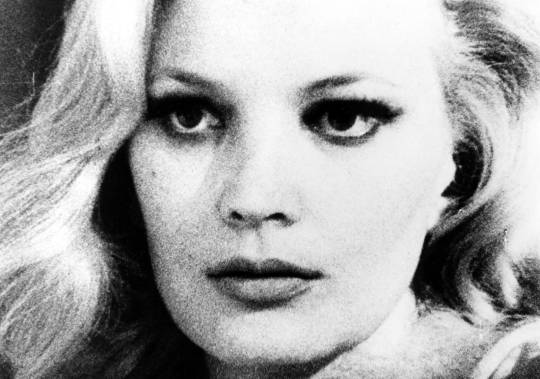
A still from “Faces.”
Contrary to myths about Cassavetes’s films, they’re not improvised. The script for “Faces” was two hundred and fifteen pages long, and Cassavetes wrote the dialogue. What’s not written out is the actors’ physical behavior. They’re free to live out the action uninhibitedly, with Cassavetes’s camera following them in their lurches and dances, their tussles and their embraces. The entire cast, featuring veteran actors (such as John Marley, as the husband) and nonprofessionals (including Lynn Carlin, as the wife), performs with unreserved energy and passion, but it’s Rowlands who, in just a few scenes, expands the boundaries of movie acting. The role is one that has the notion of performance built into it—Jeannie is performing love and desire for her client—but the story involves an emotional reality that bursts through this convention-bound relationship.
The sex worker with a heart of gold is a well-worn type, of course, something that the movie confronts head on, yet there’s nothing hackneyed or even familiar about the way that Cassavetes films this character—or about how Rowlands brings her to life. Jeannie’s tragedy is that she is unable to fit into the conventional contours of her transactional role and instead brings her whole self, all her torrential, impulsive emotionalism, to her work. Her intensity provokes Richard into a wrenching-away of façades and engenders a contact of souls far more galvanic than the contact of bodies—until the transactional and the conditional snap back. Rowlands pours herself completely into Jeannie’s ratcheted-up gaiety and forceful control of tough situations, her rapturous tenderness and devastated disappointment. Cassavetes’s filming matches her beat for beat, throb for throb, leading to a closeup of such melodramatic starkness and catastrophic self-awareness that, to my mind, it’s the closeup of closeups, the one that could stand for the entire historical repertory of cinematic intimacy, of the art of the face.
In Cassavetes’s films, Rowlands was able to give of herself comprehensively, to be herself and to allow the wildest extremes of feeling to overwhelm her on camera. This isn’t solely because of the couple’s personal bond. It’s also because Cassavetes, behind the camera, is giving of himself completely, too, in his responsiveness to the people he’s filming and the situations that they create. She and he seem almost to be meeting at the surface of the image, yielding a sense of shared risk, shared vulnerability, and equality.
Rowlands’s performance in “Faces” set the definitive tone for Cassavetes and his films, as well as for herself. In Cassavetes’s 1963 studio movie “A Child Is Waiting,” Rowlands, who co-stars, is skillful and focussed, with a strong presence but an unexceptional manner. In “Faces,” more than a star is born—she reveals an entire new dimension of acting. She wasn’t in his next film, “Husbands,” from 1970 (in which he co-stars with Peter Falk and Ben Gazzara), but his performance confirms her influence. He was already highly original, but “Faces,” in which he doesn’t appear, produced a watershed in his own performances, and in the acting of his movies in general—a form of acting that the entire future of cinema would be forced to reckon with.
By the time Rowlands and Cassavetes made their next movie together, “Minnie and Moskowitz” (1971), they had turned forty, and, in that post-sixties moment, with its slogan of never trusting anyone over thirty, the suburban world of “Faces” was already old-fashioned. Yet, as if to overcome the facile determinism of a generational dividing line, it was this cinematic couple that was singularly rejuvenating the art of movies, dispelling pretenses of comfort and tranquillity to give full and florid expression to the stifled emotions that it concealed. The couple’s films don’t talk politics, but the way that they defied movie conventions to depict experiences with unprecedented intensity gives them a manifest social and metapolitical power.
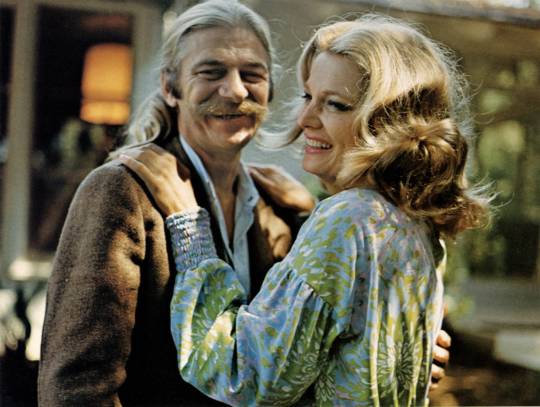
Seymour Cassel and Rowlands in “Minnie and Moskowitz.”
In their 1974 drama “A Woman Under the Influence,” Rowlands, playing the wife of a construction foreman (Peter Falk), confronts the raw and repressive power of working-class masculinity, in a performance that, for all its fury and reckless playfulness, has a finely composed dramatic arc and a manifest virtuosity. Despite this sense of more careful composition, its scenes from a marriage and its vision of family life are nearly unbearably painful to watch; they were agonizing for Rowlands to portray. In 1976, Rowlands was in the room when Cassavetes was interviewed about the film by a journalist from Le Monde, who asked her if she’d thought of directing Cassavetes in a movie. She first jokingly pretended to strangle her husband, then earnestly said that she didn’t want to direct, then added, “No, sometimes, after difficult scenes, I’d like to turn the camera on John, especially to get revenge . . . ”
Having taken naturalistic drama to unprecedented extremes, the couple next explored the very nature of performance, in “Opening Night” (1977), surely the most powerful and imaginative movie about actors—and about an actress—that exists. Rowlands plays Myrtle Gordon, an actress cast in the lead role of a play by an elderly playwright (Joan Blondell), the subject of which is the character’s transition from youth to maturity. The role terrifies Myrtle, emotionally and professionally: she feels that it will mark the end of her career as she knows it, and it also forces her to confront her own age (which is unspecified, but Rowlands was in her mid-forties). It’s also the story of Myrtle’s terror and horror at one particular moment of stage business—when a co-starring actor named Maurice (Cassavetes) is supposed to slap her.
What Myrtle does, in the face of her resistance to the play’s text and to its direction, is to explode the play in real time, forcing Maurice and the rest of the cast to improvise along with her, to the horror of the playwright but to the delight of the audience in the theatre where the play is opening. Those improvisations (most of which were indeed written) range from the dangerously passionate to the uproariously capricious—and Myrtle delivers them as if directly addressing the audiences attending the play and breaking the fourth wall, and forces Maurice to do the same. It’s as if the actors are tipping their hands at movie viewers as well, suggesting the vast personal realities that fuel great screen performances. Most actors and most filmmakers, bound by industry norms or crowd-pleasing conventions, don’t even hint at such realities, but Cassavetes and Rowlands broke open the screen to let them flood into the world at large. The essential art of Rowlands, the art that she and Cassavetes shared in public and in private, was the art of life, the art of love. ♦
10 notes
·
View notes
Text
What is your favourite Doctor Who story?


ROUND 2 MASTERPOST
synopses and propaganda under the cut
Mad Dogs and Englishmen
Synopsis
"Grrrrr."
The greatest book ever written.
Professor Reginald Tyler's The True History of Planets was a twentieth-century classic; an epic of dwarves and swords and wizardry. And definitely no poodles. Or at least there weren't when the Doctor read it.
Now it tells the true tale of how the Queen of the poodles was overthrown; it's been made into a hit movie, and it's going to cause a bloodbath on the dogworld — unless the Doctor, Fitz and Anji (and assorted friends) can sort it all out.
The Doctor infiltrates the Smudgelings, Tyler's elite Cambridge writing set of the early twentieth century; Fitz falls for flamboyant torch singer Brenda Soobie in sixties Las Vegas, and Anji experiences some very special effects in seventies Hollywood. Their intention is to prevent the movie from ever being made. But there is a shadowy figure present in all three time zones who is just as determined to see it completed... so the poodle revolution can begin.
Propaganda no propaganda submitted
The Crooked World
Synopsis
The people of the Crooked World lead an idyllic existence.
Take Streaky Bacon, for example. This jovial farmer wants nothing more from life than a huge blunderbuss, with which he can blast away at his crop-stealing nemesis. And then there's Angel Falls, a racing driver with a string of victories to her name. Sure, her trusted guardian might occasionally put on a mask and menace her for her prize money, but that's just life, right? And for Jasper the cat, nothing could be more pleasant than a nice, long nap in his kitchen — so long as that darn mouse doesn't jam his tail into the plug socket again.
But somebody is about to shatter all those lives. Somebody is about to change everything — and it's possible that no one on the Crooked World will ever be happy again.
The Doctor's TARDIS is about to arrive. And when it does... That's all folks!
Propaganda
I think that the best thing about EU stories is that, by the nature of their medium, they can tell stories that couldn't be shown on the TV due to constraints ranging from TV sensors to budget limitations to the fundamental laws of reality. This is maybe the best example of how the novels can transcend all of that. The action takes place in a world of cartoons, where goofy characters chase each other around and do comedy bits. Sometimes they blow each other up, but they're always fine by the next scene, so it's okay! Enter the TARDIS. The Doctor gets shot in the chest within literal moments of leaving the ship, and his apparent inability to heal sends shockwaves through the denizens of the Crooked World. The travelers' attempts to repair the damage only result in worsening it, as for the first time, the cartoons learn about violence, death, sex, and the fundamental inequalities of their society, culminating in riots in the streets, murder, and the attempted destruction of the world. (Spoilers: the Scooby Gang discovers the corpse of God!) It's fascinating, the vast tonal shifts throughout are masterfully handled, it traumatizes and re-traumatizes you every chapter, and for my money, it's one of the best portrayals of the 'Dr. Nyarlathotep' concept in the EU (though that probably wasn't intentional) (6&7)
31 notes
·
View notes
Text
DOCTOR WHO TOP 10 - 9th Doctor
Ninth Doctor. I love him, you probably love him too. He's great. Let's go.
10. The Cruel Sea

Rob Shearman's very weird comic strip. Admittedly, I love it to bits. While I think Shearman wasn't entirely sure about what he's doing, the result is still by far ninth Doctor's best DWM comic. (Okay, I also really like Scott Gray's Monstrous Beauty, it just didn't make the list.)
9. The Beast of Babylon

I love xenofiction and Doctor Who should do it more often.
8. The Sin-Eaters
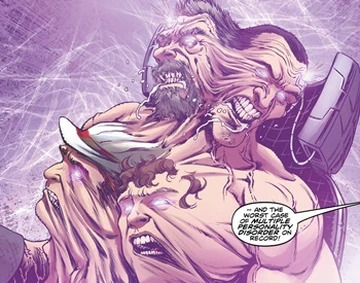
Ninth Doctor's Titan comic book run by Cavan Scott is on the whole pretty solid. (And preferable to ninth Doctor's 2005 DWM run, which just has too much Gareth Roberts to be any good.) I can definitely recommend the whole thing. Not everything in there is amazing, but there's a lot to like about it.
This story is my personal highlight of the run. Twisted, clever, and fun. The Sin-Eaters just slaps.
7. The End of the World
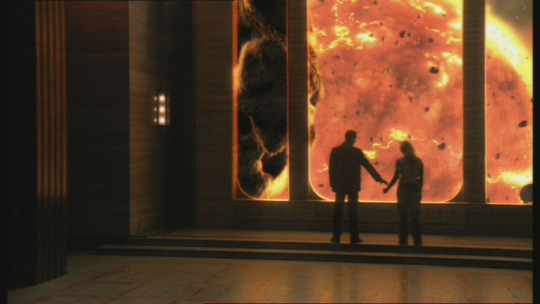
The moment Tainted Love starts playing, you know you're in for something amazing.
I just love this episode... It's the first episode of New Who that really gets to show off the scope of "the alien" in this universe. I adore the creativity of it, the energy of it. And Lady Cassandra O'Brien.Δ17, of course. So many iconic moments in this one.
6. Bad Wolf / Parting of the Ways

The big finale, of course. Huge, emotional, epic... but also featuring some biting satire about the landscape of television. The perfect finale to the first series.
5. The Stealers of Dreams
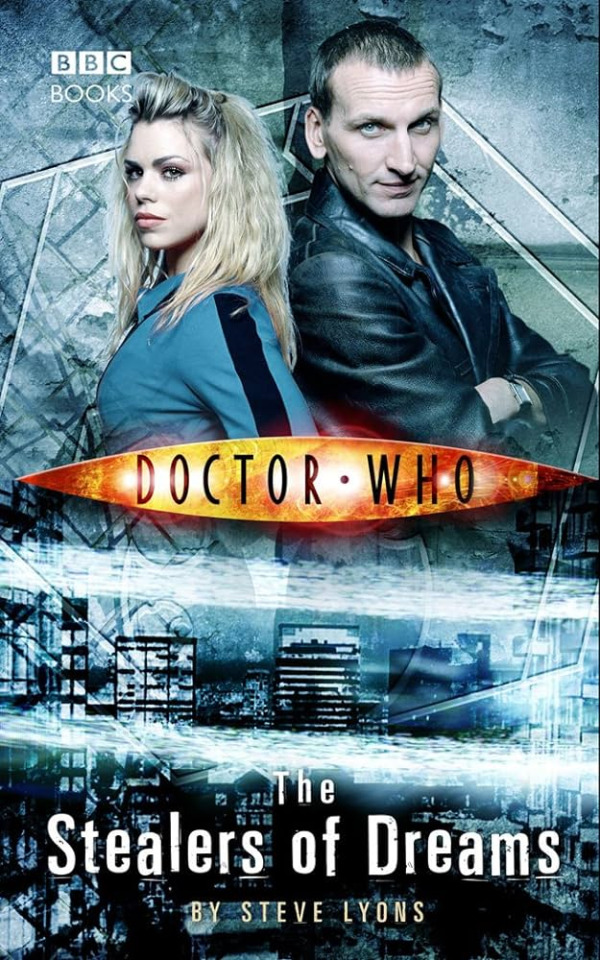
My favourite ninth Doctor book. It's kinda Cartmelian in it's premise, but also deals with the new reality for the eu - Doctor Who being back on TV. This is a stunning Who novel and it should get a lot more attention than it does. Steve Lyons is awesome.
4. Monsters in Metropolis

Historicals about film history are great and there should be more of them. Also, this one made me cry, so there's that. I love Monsters in Metropolis so goddamn much, thank you John Dorney.
3. Planet of the End

After listening to the first series of Big Finish's The Ninth Doctor Adventures, one gets a pretty clear sense that Respond to All Calls is the strongest of the four boxsets, by a pretty wide margin.
My favourite of that boxset has to be Planet of the End by Timothy X Atack. There's just something about the size of the ideas in this one... Fred is an amazing character, the Incorporation are truly villainous... Just thinking about this one makes me want to listen to it again.
2. Dalek
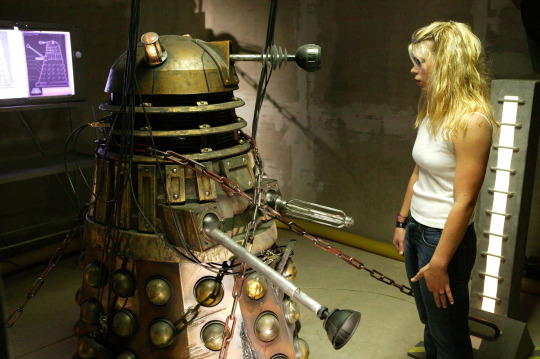
Rob Shearman resurrects Daleks. Well... just one, to be precise. But it's all he needs to craft one of the greatest Dalek stories every. Every line is gold, the story is poignant and meaningful, the characters are memorable... And it's a Base Under Siege story where the monster is trying to get out instead of getting in. What more do you want?
1. The Empty Child / The Doctor Dances

What else could it be? Steven Moffat's Hilarious & Horny Horror For Children, also known as The Empty Child two-parter, has become such an iconic and defining bit of Doctor Who. I feel like everyone loves it and for good reasons. It's absolutely deserving of all the hype and acclaim. And... You know... Everybody lives!
#doctor who#9th doctor#ninth doctor#christopher ecclestone#doctor who eu#60th anniversary#top 10#dfpost
14 notes
·
View notes
Text
Current History is the Best Reality Show
I was born in the Bronx in the 60's, I've never voted. Never really liked either side but I definitely supported Democrats since Carter was elected, then the Democrats burned my country down from 2016 to 2020. I'll never trust a Democrat for the rest of my Life. Independent Forever! Clearly there was an underlying Hate inside that cult that I never knew existed. Stupid me I guess. But I don't condone violence. These people burned my country down because they lost an election? Are you kidding me? I've watched the System since the 60's. A guy from one team wins then a guy from the other team wins. It's a checks and balances System so that neither the Far Left or the Far Right take over Forever. They hold on for 4 to 8 yrs then it bops back and forth. It's been that way since day One, and it's worked so well that it built the greatest country ever, in the history of the world. Don't give me the racist Hate speech because African Americans gave birth to Americans, and a Black American became the President of the United States of America. (don't forget I supported Democrats at that time) On election day 2008, when I saw that big old black lady waving the American flag in Washington D.C. crying tears of what you can only call Emancipation….I balled my facking eyes out for hours that night. One of the best moments in that I've lived through. It finally happened. But The Constitution has held up for over 250 years, and it will for another 250 years if Democrats get back to behaving like civilized human beings instead of sore losers. We're into the 4th year of the Biden presidency and I still don't see any Republicans burning buildings down. Why? Because Republicans abide by the rules and they know they just have to regroup and try next time, and get out and Vote. They don't want to burn their neighbor's businesses down or harm other people.(and yes they have some crazies, but Democrats have crazies too. Believe me I've watched this country's clown show for over 50 years, both sides are Facked up. you're both literally psychotic with what you believe in) Republicans just want a President they support, so they wait and they Vote. Sometimes they win, sometimes they lose. And now we're in a New World, a World full of Hate from every direction. If you say you don't like dog sh!t you'll get cancelled. It's a very wacky World. I'm just a bystander…watching this nutty World unfold…I'll tell you right now, the Alphabet people have taken over. Like I said I'm just watching this shyt happen and it's very noticeable to me that the Alphabet people now hold Powerful positions in every aspect of the World…from corporations, to small businesses, from entertainment to sports, to movies, tv, and commercials, and education and government…if you haven't noticed it, they are in Power in the United States….and why is that? Because Alphabet people only Hire More Alphabet people. An ingenious strategy and clearly it works. (hahahah I guess that's how the Traditional World also worked but now the Alphabet people picked up the skill and they're using it to their advantage) Whoever is leading them in their mission, is freaking brilliant. They have monopolized all aspects of Life in America. The "Traditional World" isn't just under siege, it's battling for survival, literally breathing it's last breath. I'm literally living through History. What's funny is that I can tune in any day that I want, to see this week's episode.
0 notes
Text











World Television Day
The first World Television Forum was staged by the United Nations in the mid ’90s, and it was out of this event that World Television Day was born. The forum brought together leading figures from the media industry to analyze the growing impact that TV had on decision-making and public opinion when it comes to issues of peace and security around the planet.
The History of World Television Day
In December 1996 the United Nations General Assembly proclaimed the 21st of November World Television Day, the same year the first World Television Forum was held. Acording to the United Nations, this decision was taken in order to give recognition of the increasing impact television has had on decision-making by bringing various conflicts and threats to peace and security to the world’s attention, as well as its coverage of other major issues, including economic and social. World Television Day is not meant to be so much a celebration of the electronic tool itself, but rather of the philosophy which it represents–a philosophy of openness and transparency of world issues. Television has long been thought to represent communication and globalization in the contemporary world. However, not all of the government representatives present saw matters quite that way. The delegation from Germany said, “Television is only one means of information and an information medium to which a considerable majority of the world population has no access… That vast majority could easily look at World Television Day as a rich man’s day. They do not have access to television. There are more important information media and here I would mention radio in particular.”
How to Celebrate World Television Day
The most obvious way to celebrate World Television Day is by watching television. But what? Surely not vulgar reality shows offering little to no value of any kind to their audience? World Television Day is a time to rewatch and relive some of the greatest moments of television that helped bring the reality of a rapidly technologically advancing world into people’s homes, forever changing their lives and how they perceived the world. 1954 marked the launch of Disney’s “Wonderful World of Color”, a family-friendly variety program that mixed iconic cartoons, drama and documentary programming. The very first televised presidential debate between Republican Vice President Richard Nixon and his challenger, relatively unknown Massachusetts Senator John F. Kennedy in 1960 changed the presidential elections forever. For the first time ever, American voters actually saw the candidates present their ideas, which worked greatly in favor of the young and handsome Kennedy, who went on to win the election. And few moments, if any, in television history could ever surpass Neil Armstrong, Michael Collins and Ed “Buzz” Aldrin’s moon landing in 1969, which many people consider to be a pivotal moment in their lives until this very day–after that, nothing was going to be impossible again.
World Television Day was established as a way of bringing focus back to these issues on an annual basis. In years gone by major TV stations have come together on the day to broadcast tributes to the importance of television in people’s lives. The obvious way for anyone to celebrate is to turn on their TV and watch. Those that want to become more involved and have ideas about how to honor the day are welcomed to send their thoughts to the official website.
Source
#Östersund#Tyresö#Sweden#Sverige#World Television Day#TV#travel#summer 2020#Seeheim-Jugenheim#Germany#AirBnB#WorldTelevisionDay#L'Hotel#Montréal#Sofitel Philadelphia#Revelstoke#USA#Canada#summer vacation#interior#Le Saint Pierre Auberge Distinctive#Québec#Quebec City#original photography#Toad River#vacation
1 note
·
View note
Text
Don't Fear Weakness
Today's inspiration comes from:
Soul Fuel
by Bear Grylls
Editor’s note: "'Bear Grylls is a survivor. You’ve likely seen him on one of his many survival and adventure TV shows, such as Man Vs. Wild, You Vs. Wild, The Island, and Running Wild with Bear Grylls. In his life, Bear has served with British special forces, climbed Everest, crossed the north Atlantic unassisted, and he currently holds the record for the longest indoor freefall! But as much as Bear knows about adventure and survival, he’s come to realize that a deeper source of strength is needed in this life. As Bear says, “I find the journey hard. I often mess up. I feel myself teetering on the edge more often than you would imagine. So for me, starting my day with God really helps. It is like food. Like good fuel for the soul.” In his book Soul Fuel, Bear Grylls offers up 365 devotions, many of which he wrote on his phone during his countless adventures. Enjoy two selections today from Bear in Soul Fuel."'
"'Don’t Fear Weakness
I often feel inadequate because of my many weaknesses. But sometimes God works through our weaknesses better than through our perceived strengths.
We see it in Gideon. Chosen by God to lead an army, he didn’t feel that he was up to the job.
“Pardon me, my lord,” Gideon replied, “but how can I save Israel? My clan is the weakest in Manasseh, and I am the least in my family”. — Judges 6:15
Often our doubts and fears only really surface when we’re about to be tested. But our sense of weakness is no barrier to God. “I will be with you,” said God to Gideon. And He says it to us too.
I often draw strength from the words of the apostle Paul:
Therefore I will boast all the more gladly about my weaknesses, so that Christ’s power may rest on me… For when I am weak, then I am strong. —2 Corinthians 12:9-10
Don’t run or hide from your weaknesses. Accept and embrace them, and lay them before the Almighty. He longs to enter, transform, and empower our lives. It is what He does — but only when asked, and only when there is room for Him to work.
A false sense of self-confidence often gets in the way of our progress in life. There’s a power to weakness, strange as it sounds. But when we admit that we’re unable to fight the big battles alone, that is when we learn to effectively rely on a stronger power. God-confidence is always going to win over self-confidence. Gideon knew that, as have so many of the most empowered men and women throughout history.
Don’t run or hide from your weaknesses. Accept and embrace them, and lay them before the Almighty.
The Curtain Between Man and God
It is arguably the most poignant moment in human history: Pilate turned and looked at Jesus. Covered in blood, a crown of thorns biting into His scalp, soldiers on either side, Jesus didn’t look like much of a threat to the Roman ruler. I imagine Pilot half sneering, half despairing as he spoke:
Don’t you realize I have power either to free you or to crucify you? — John 19:10
But Jesus’ reply was so calm and clear:
You haven’t a shred of authority over Me except what has been given you from Heaven. — John 19:11 MSG
It must have looked to many as though it was game over, as though Jesus’ life had been a failure — that hatred, jealousy, and ego had conquered over mercy, forgiveness, and love. But in reality, the greatest victory in the history of the world was about to be won. The conquered one, the man who looked as if He’d failed, was about to reveal a source of new life, a new vision for humankind, a new road to peace and unity.
At that moment, the Temple curtain was ripped in two, top to bottom. There was an earthquake, and rocks were split in pieces. — Matthew 27:51 MSG
Whenever we’re struggling with the circumstances of our lives, let’s see beyond what other people see as failure and look instead to what God’s doing behind the scenes in our lives. Let’s choose to remember that the greatest triumphs sometimes occur when the circumstances seem to be hardest.
He went through it all — was put to death and then made alive — to bring us to God. — 1 Peter 3:18 MSG
When we think life is dark, Christ knows better. Look up. The light is coming."'
Excerpted with permission from Soul Fuel by Bear Grylls, copyright BGV Global Limited, 2019.
0 notes
Text
Multimedia Blog 3 - taylorcassidyj
Taylor Cassidy (@taylorcassidyj on TikTok and Instagram) is a social media content creator and advocate with over 2 million followers on TikTok and over 200K on Instagram. Her content is centered around teaching Black history and spreading Black joy through engaging videos on TikTok, Instagram, and YouTube. She joined TikTok in 2019 where she began a series called “Fast Black History,” 1-minute videos about African American historical figures. Her following quickly grew amassing over 69 million likes on TikTok. Along with the “Fast Black History” series, she created the “Black Girl Magic Minute,” uplifting influential Black creatives. Cassidy has accomplished so much at the age of 20. She is from St. Louis, MO, where I am from! Growing up, we were in the Little Mermaid Musical together which inspired me to write about her. Cassidy is truly an influential figure of our generation and plans to take her advocacy on screen in films/TV.
In Cassidy’s “Black Girl Magic Minute” TikTok series, she celebrates Black creatives. Cassidy started this segment “to not only give credit back to these Black creators, but to uplift them and let people – even people who aren’t Black – discover new creatives and new, amazing people to follow and support” (Novato). In one discussion we focused on Judy Baca, a muralist who uses digital technology to create designs. She uses these designs to create murals in LA whose purpose goes beyond artistic value. They have social influence and are used as a political tool by representing most of the population who are usually voiceless. Cassidy and Baca are similar in giving a voice to the voiceless through different forms of media. Baca bases her art on people and uses digital technology to turn these ideas into reality, while Cassidy uses technology in a different form to convey her message. By uplifting Black creators, their platform can grow, and they can continue to grow doing what they love. Cassidy hopes to make “Black Girl Magic Minute” into a podcast to dive further into the subject.
As mentioned in our readings and discussions, the Harlem Renaissance was an influential moment in history for African Americans. The Harlem Renaissance was centered around Black pride, like Taylor Cassidy’s content. Post emancipation, many Black people in the south became sharecroppers and tenant farmers. In this position, they were in debt to white “landlords” and therefore in “economic bondage” despite being free (Takaki). Because of this, many Black people were eager to leave the south and find work up north. After a mass influx of Black people from the south, a sense of Black pride was formed in Harlem. Known as “the greatest Negro city in the world,” droves of Black people came from everywhere to experience the culture found in Harlem (Takaki). Black educational and economic success spread throughout the community. This is a typical topic Cassidy would create a “Fast Black History” video on. One of her TikTok videos mentions Glady Bentley, an American blues singer, pianist, and entertainer during the Harlem Renaissance. In the video, Cassidy dresses up as Bentley making it entertaining and educational. As mentioned in the video, “it was argued that [Bentley] was a drag king, but it was more that she dressed more masc to get jobs in Harlem night clubs during the Harlem Renaissance” (Taylor Cassidy). Bentley used her intersecting identities to her advantage so she could showcase her talents. The Harlem Renaissance was an opportunity for African Americans to express and create, similar to Cassidy’s social media content creation.


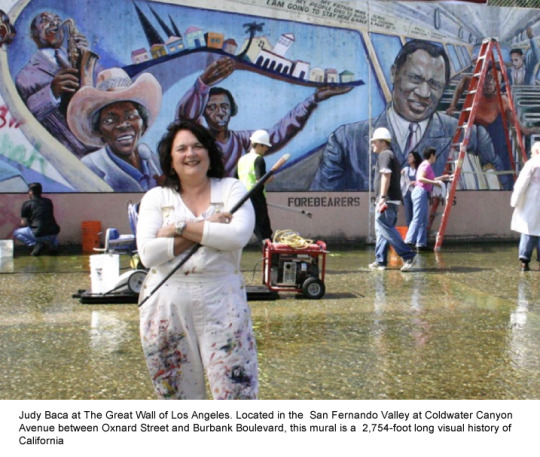
youtube
Works Cited
“Best of Fast Black History TikToks (Black Music, Pop Culture, and More!) | Taylor Cassidy.” YouTube, uploaded by Taylor Cassidy, 26 March 2021, https://youtu.be/1OZcOMwk5B0.
“Black Girl Magic Minute | Official Trailer | Taylor Cassidy.” YouTube, uploaded by Taylor Cassidy, 24 April 2021, https://youtube.com/shorts/YX9Vkp8dlh8?feature=share.
Campano, Leah. “Taylor Cassidy Makes Black History Accessible to Millions with a Viral TikTok Series.” Seventeen, 27 Feb. 2023, www.seventeen.com/life/a43050504/taylor-cassidy-voices-of-change/.
“Judy Baca.” California State University, Northridge, 15 Oct. 2015, www.csun.edu/mike-curb-arts-media-communication/judy-baca.
Novato, Olivia. “Taylor Cassidy: The Educator on Teaching Black History, 'Black Girl Magic Minute', and More.” Taylor Cassidy | The Educator on Teaching Black History, 'Black Girl Magic Minute', and More., flaunt.com/blog/taylor-cassidy.
Staff, Teen Vogue. “Teen Vogue's 21 Under 21 2021: The Young People Shaping Tomorrow.” Teen Vogue, Teen Vogue, 14 Dec. 2021, www.teenvogue.com/gallery/teen-vogues-21-under-21-2021.
Takaki, Ronald T., 1939-2009. A Different Mirror : a History of Multicultural America. Boston :Little, Brown & Co., 1993.
Taylor Cassidy [@taylorcassidyj]. “learn more about Gladys Bentley in my bio!” TikTok, 27 July 2022, https://www.tiktok.com/@taylorcassidyj/video/7125167391683743022?is_from_webapp=1&sender_device=pc&web_id=7156437192771192366.
@tamarakjohnston
0 notes
Text
Well, it’s not quite a master’s thesis, but this is (the first of) a series of posts on why Catra and Adora are the best love story in the history of kids TV animation and maybe the greatest love story in the history of TV. This may in some ways be faint praise - romance on TV is generally not very good compared with books or movies. Often it’s just some will they/won’t they sexual tension that is defused by getting characters together and re-heightened by breaking them up. TV is full of nearly shark jumping pointless dramas like Sam and Diane (Cheers, holy fuck am I dating myself, though that was technically before my time), Ross and Rachel (Friends, which was no Cheers) etc, but also some less annoying couples like Ben and Leslie (Parks and Rec) or Amy and Jake (Bk99) who are mostly just kind of cute and fun. Other shows, like the X-Files, teased viewers for years with unresolved sexual tension. In kids shows most romances are, appropriate for their target viewers, mild, sweet relationships based more on self-conscious flirting and blushing than on complex and conflicted feelings or deep passions - which is pretty realistic when the characters are young teens or even mid-teens. Some of these relationships are really well done - Finn and Flame Princess, Dipper and Pacifica (yeah I ship them), the early stages of Katara and Aang (before the showrunners imbued this childhood crush with cosmic significance), Steven and Connie, etc. Catra and Adora, though, are different. Their love story is not a side plot or a sub plot, it’s the heart of the show. It isn’t a childhood crush, it’s a very messy and passionate relationship between two young adults. She-Ra is an emotionally complex lesbian romance just as much as it is a thrilling action/adventure show. Everything about their relationship is baked into the show’s plot, its themes, hell even its musical score. The dramatic tension between Catra and Adora is not the result of stretching out a flirtation for ratings, but a coherent dramatic arc that runs through the entire show. As Noelle said, he made Catradora so central that execs couldn’t take it out without ruining the show. And the show is better for it. In this series of posts I’m going to try to show why, as well as showing why She-Ra is such a fantastic love story.
First off, let’s talk about how Catra and Adora’s character arcs are foils for each other, and how they come together and apart through the series. This is actually a post that I’ve been working on for a while but I keep summarizing the show rather than cutting to the chase, so I’m not going to recite many plot points so much as sketch out what’s going on with the dramatic structure at the time. But also, let’s talk about what each character’s arc is saying, and how they are commenting on each other. Spoiler alert: Catra’s arc is a subversion and critique of stories of empowerment through ruthless self-assertion and revenge, while Adora’s arc is a subversion and critique of chosen one narratives and stories of self-denial and self-transcendence.
When the show starts, Adora and Catra are shown as rivals and friends - their first scene starts the recurring motif of them reaching out for each other as one of them dangles above an abyss, as well as establishing their flirtatious banter and easy camaraderie. We quickly learn that these two young women plan to conquer the world together. These scenes and later flashbacks show Catra and Adora as deeply enmeshed in each others lives, to the point where neither of them (but especially Catra) have clear identities outside of one another. There is so much genuine love on both sides before Adora leaves, but also resentment, envy and fear, especially on Catra’s side, as well as a protectiveness on Adora’s side that deprives Catra of her autonomy. They are both being abused by Shadow Weaver - Catra physically and emotionally, Adora emotionally. It wouldn’t be too much to say that Shadow Weaver holds Catra hostage to control Adora (this is why critiques that Adora abandoned Catra to be abused are actually kind of messed up, since they accept Shadow Weaver’s premise that Adora is responsible for what Shadow Weaver does to Catra). In addition, Catra and Adora actually see the world incredibly differently. Adora already sees the world in terms of right, wrong and her destiny to right wrongs - this is why it’s important for her to accept the Horde’s obvious lies - she couldn’t keep living if she didn’t. Catra, on the other hand, sees the world solely in terms of survival and personal loyalty - everything for her is about preserving herself and the person she cares about - Adora.
Then, when Adora finds the sword, she leaves because it’s the right thing to do. Catra doesn’t even have a concept of ‘the right thing to do’ being something she should care about, or perhaps, something she can care about as an irredeemably evil, awful fuck-up. So at Thaymor neither one understands where the other is coming from, and Catra and Adora begin to part. This is the first turning point in their relationship. Adora chooses duty over what she desires, Catra chooses to protect herself (such as she sees it) and nurse her sense of betrayal and abandonment.
Their relationship until Promise is a kind of weird Frenemy thing that is fascinating to watch and sold me on the show. Neither one wants to fully admit to themselves that the other is now their enemy, neither one has given up on changing the other’s mind. Each is furious at the other, and desperate to see her again at the same time. There’s a lot of heartache and just as much sexual tension, especially at Princess Prom. Both of them come alive when they fight each other (more about that in a later post). But they’re already growing apart - Adora embracing her destiny as She-Ra, Catra rising in the ranks for the Horde. Adora now has the purpose she always wanted, plus other friends and a sense of being chosen to do something great, while Catra now has power - the means to protect herself from people like Shadow Weaver as well as the vindication she had always been denied, and even the opportunity to beat Shadow Weaver at her own game.
The next turning point is Promise. Holy fuck, this episode. It’s an episode that is even more heartbreaking after you’ve watched the show because you know just how much worse things are going to get, and yet, it’s a necessary part of both of their character arcs. Even through season 1 Catra and Adora had remained very much enmeshed in each others lives in an increasingly fucked up way as they grew apart but refused to turn away from each other. Even though they aren’t -exactly- a romantic couple (Adora doesn’t recognize and acknowledge her feelings until the last episode of Season 5), Season 1 of She-Ra is one of the worst breakups I have seen on TV. As I said in a couple of previous posts, this is the kind of shit that the Mountain Goats write songs about. Everything that was poisoning their love for each other even before episode 1 bubbles to the surface and combines with them fighting on opposite sides of the war to make a truly fucked up situation. In the end, it’s Catra that makes the choice to turn away from Adora. This isn’t a -good- decision. It’s spiteful, and destructive, and based on an outright deluded understanding of their relationship (inspired by Light Hope’s manipulations and her own issues), but it’s in some ways a necessary decision. Catra has been so wrapped up in Adora for so long that she isn’t going to be able to figure out who -she- is without cutting Adora out of her life. And the same is true of Adora.
But each of them do this in about the worst way possible. Catra embraces destruction, ambition, manipulation and outright cruelty, turning the tactics of her abusers against them and against everyone around her. She first triumphs over Shadow Weaver and manipulates Entrapta into trying to corrupt Etheria itself. Meanwhile Adora ‘lets go’ and commits herself to the self-denying mantle of She-Ra. Over the next several seasons, their respective paths will nearly lead both Catra and Adora to their deaths (in the Season 4 finale).
For the next season (counting season 2 and 3 as one) Catra and Adora are still closely linked, but as enemies. Still, there’s more than enough flirtation between them (that ‘Hey Catra’ in the first episode of Season 2 is something else), and especially on Adora’s side we see her hold back with Catra, and often take responsibility for the harm Catra inflicts, just like she had when they were kids. Yet they still drift apart - after facing off every other episode in Season 1, they spend less and less time on screen together through season 2 and 3. Catra continues her ascent to power and descent into villainy while Adora becomes more of a stressed out mess as she takes the fate of the world and the wellbeing of everyone she cares about on her admittedly broad shoulders. Catra’s one moment of vulnerability is rewarded by Shadow Weaver’s betrayal and her exile, then Catra triumphs in ruthless badass fashion through sheer desperation and aggression. In the Crimson Wastes, we see Catra at her most independent, and she almost seems happy. But once Adora shows up and Catra hears about Shadow Weaver, she’s sucked back into the worst of her resentments, and she makes very clear that being happy is less important to her than making sure Adora is miserable.
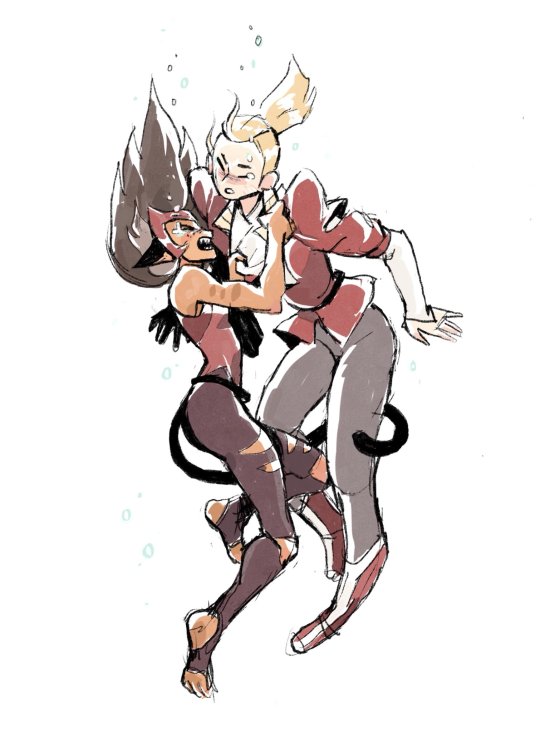
This changes everything. Catra completely breaks with reality and tries to kill Adora, herself and the world rather than lose to Adora and Shadow Weaver (I do think it’s important to remember that she does that after Shadow Weaver nearly kills her). Catra betrays everyone around her when she exiles Entrapta, threatens Scopria and lies to Hordak. Then she flips the switch. When Adora tries to fix things, Catra fights to her own death to make sure that the world disintegrates with her. For her part, Adora fights first to understand what is wrong with the world and then to fix it. Finally she tells Catra that destroying the world is her choice and she has to live with it, decks her, and then sees her off with a death glare once the portal is closed. With this, Adora writes Catra off even if, as she says later, she never never hated her. By doing that, Adora casts off the guilt that had dogged her and takes responsibility for her own life rather than someone else’s - this is actually a huge step for her, and one that will become more important in Season 4.
Season 4 is in many ways the nadir of their relationship. They only see each other once during the entire season, in Fluterrina, when Adora tries to blast Catra, much to the latter’s shock. There’s a sense in that scene that Catra is trying to have the same flirtatious enmity she used to have with Adora, and Adora is having none of it. Catra almost seems hurt by this, which is an early hint at how isolated Catra is beginning to feel. Catra spends the rest of the season at her highest and lowest. On the one hand she spends most of 12 episodes winning by every standard she has ever claimed to care about, besting Hordak himself in single combat and making herself co-ruler of the Horde and coming within a day’s march of ending the Rebellion. In many ways it is the ultimate empowerment fantasy - the abused young woman has defeated her abusers, showed up everyone who doubted her and forced everyone to respect her. But I think it’s striking that the show starts with her and Adora dreaming of conquering the world together and in Season 4 Catra nearly succeeds in conquering it alone, almost like she was trying to live out her old shared fantasy while proving she didn’t need her former best friend.
At the same time, Catra is clearly miserable. She’s always been unhappy, but in Season 4 we see her completely isolated and lying to herself and everyone who will listen in a desperate attempt to justify her actions. Turning the tactics of Hordak and Shadow Weaver against them to gain power and then against Scorpia and Entrapta to maintain it haven’t vindicated Catra, they’ve made her more and more alone as Entrapta is exiled and Scorpia drifts away. Meanwhile Catra reaches out to Double Trouble, and her interactions with them reek of a kind of desperate desire to have someone in her life (the feeling of their interaction is of an unhealthy casual relationship where one partner becomes emotionally invested and the other takes advantage of that while denying the other the closeness they desire). As people leave her, one after the other, it becomes clearer and clearer that Catra doesn’t want power at all - she wants connection, friendship, love, and power is a very poor replacement. As I said in my long Catra rant, Season 4 is both her ‘Walter White as a Catgirl’ season and the beginning of her redemption. Everything comes to head when Sparkles destroys everything Catra has tried to achieve, Double Trouble delivers those harsh truths and Horde Prime shows up and makes it all irrelevant, just highlighting how futile all her struggles and sacrifices and crimes have been.
Meanwhile Adora spends Season 4 becoming her own her and her own woman. After telling off Catra, she grows more and more disillusioned with Light Hope and critical of Glimmer (though the latter has more than a shade of her old habit of taking responsibility for others - Adora’s development is not linear). She’s gained the courage and confidence to strike out her own path, not just follow a destiny. At the season’s end she once again breaks with her best friend to do what is right, and discards the destiny that she was being prepared for. But in this case she isn’t chasing one packaged destiny for another, instead she’s making her own choice and literally shattering the thing that she thought gave her life purpose. It’s badass, and heartbreaking, and along with decking Catra and jumping after Catra into the abyss (see below) it’s the perfect Adora moment.
In many ways Season 5 starts with Catra and Adora farther apart than they have ever been. They aren’t even enemies anymore, they’re completely out of each other’s lives. And both Catra and Adora are lost at the beginning of Season 5 - Catra is useless and alone on Prime’s ship, completely defeated despite ostensibly being on the winning side, and she goes through the motions of her normal plotting without any particular conviction and none of her normal flair. Meanwhile Adora is even more miserable and self-destructive than usual, throwing herself at Horde Bots and working herself until she drops of exhaustion. In a very real way they both stay lost until they have a chance to help the other. Catra takes responsibility for what she’s done and what she can do, saves Glimmer (at least partly for Adora’s sake), apologizes to Adora, and sacrifices herself. Adora only seems to come alive when she decides to turn around, face Prime, and save the cat. And when she does, Catra and Adora’s arcs, which had separated so completely in season 4, come crashing back together to end the series.
Adora during Save the Cat is such a contrast with the uncertain, hesitant and self-destructive wreck we’ve seen so far in Season 5. This is possibly her craziest plan in 3 years of mostly cazy plans, but she never wavers or questions herself. Even when Chipped Catra appears and we see Adora’s heart break while we watch, Adora doesn’t back down or relent. She keeps at it even as the tears stream down her face. She fights better trying to save Catra without She-Ra’s powers than she fought at the Battle of Bright Moon with them. Catra’s just about as desperate - we see her cry and plead, and now is probably as good a time to any to point out how amazing a job both VAs did throughout the show, but especially in this episode, and how good a job the board artists did.
Seeing each other for the first time in a year, and only the second time since Catra blew everything up, Catra and Adora are probably the rawest and least restrained we’ve ever seen them. There’s barely any banter, no bravado, and no pretense that they are anything other than two women who desperately need each other (Prime doesn’t help with ‘You broke my heart’.) Then Catra is flung to her death, Adora jumps after her, breaks both her legs in the fall (we see her crawl to Catra, as though she couldn’t walk) and becomes the real She-Ra. It’s such a triumphant and deeply queer moment seeing a woman transformed into a warrior goddess to protect the woman she loves, and it’s the reason that, as dark as it is, Save the Cat is my Comfort Food episode.
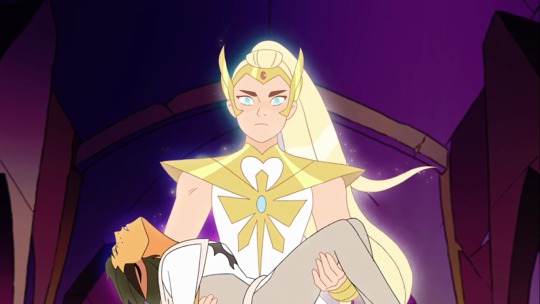
Let’s not sleep on Taking Control, though. This episode is like a microcosm of what this show does best, especially the A plot with Catra and Adora. Catra’s reversion to lashing out at everyone and her refusal to be open to Adora shows just how much of a struggle this whole ‘being good and trying to connect to people’ thing is. Catra’s outburst gives Adora a chance to stand up for herself and refuse to be Catra’s punching bag, while also not trying to control her. Adora’s ultimatum gives Catra a chance to reach out to Adora (quite literally), and allow herself to be vulnerable. In this episode, we see just how far Catra and Adora have come since the messed up stew of their relationship in Season 1. Adora lets Catra be responsible for her own actions; Catra lets herself be vulnerable to Adora and takes responsibility for her actions. They’re both better people and better friends and better partners than they were, and the show has shown this in a strikingly nuanced and realistic way.
The important thing to note in the next few episodes of Season 5 isn’t just how much closer Catra and Adora get to each other and how much they flirt (So much. So much, y’all) but just how -happy- they are. We see both of them transformed in the other’s presence. Basically, since they’ve parted, both Catra and Adora have been defined in no small part by how miserable they often are. They have both had their triumphs and their lighter moments, but there’s been a sense of melancholy dogging both Catra and Adora since episode 1. And now that they’re together again, that lifts, somewhat. Catra’s verbal barbs have lost their venom, and she can openly show how much she cares for Adora and even Bow and Glimmer. She’s still herself - snarky, cynical, somewhat devious - but she’s not engaged in a self-destructive zero-sum struggle with everyone around her. Meanwhile Adora has spent 4 seasons being a neurotic and sometimes nearly joyless mess who takes responsibility for everything and often doesn’t let herself enjoy anything other than the odd BFS group hug (exceptions include trying to uh...impress Huntara and reveling with the butterfly ladies of Elberron in Flutterina). Around Catra, though, she’s a cocky, swaggering jock who gives as good as she gets. It’s a side of Adora we’ve only seen hints of before, and one that’s so much more confident and joyful even as the world is ending around her. Apart, Catra had tried to protect and vindicate herself with power and conquest, while Adora had tried to forget herself in duty and sacrifice. Together, they can be themselves again. This dynamic is crucial to the show’s portrayal of Catra and Adora’s romance because it doesn’t just show how much they love each other, but how they’re -good- for each other now that they’ve grown as people, and that they are so much better than they were when they were apart.
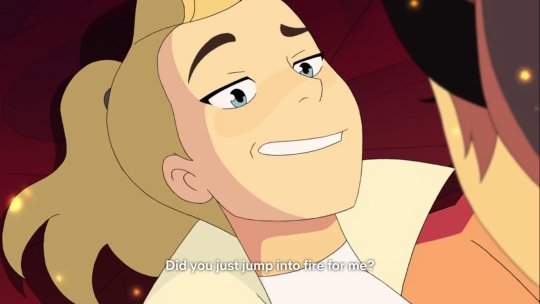
Until Shadow Weaver shows up. Their old abuser reintroduces tensions but even then things are different than they were. Now Catra isn’t just resentful of how Shadow Weaver prefers Adora - she’s protective of Adora, which is clearest in Failsafe when she calls Shadow Weaver out for being willing to sacrifice Adora. And while Adora takes the Failsafe, it isn’t to follow her destiny or because she has a death wish - it’s because she loves her friends, and she is the only one who has any hope of doing this and living (though Catra’s suggestion that Shadow Weaver take it is a good one). And finally, when Catra leaves Adora, it isn’t because she hates Adora, nor, despite what she says, is it because she really thinks that Adora chose Shadow Weaver. At least, not exactly. It’s because Catra loves Adora, and can admit that to herself, and can’t stay around and watch the woman she loves sacrifice herself rather than choosing Catra. Before Catra leaves, she asks Adora ‘What do you want?” It’s a question that echoes Shadow Weaver’s speech in Episode 1: ‘isn’t this what you always wanted since you could want anything?’ As much as Adora has grown as a person, and defined herself and stood up for what she thinks is right, she still has never answered that question - it’s never been ‘what do I want’ but ‘what do I have to do?’ and that’s how Adora answers Catra’s question. This is Adora’s last gasp as a self-transcending hero, letting go of what she wants (not that she ever dared articulate what that was) in order to do what must be done. And it nearly kills her and dooms the universe, because Adora can’t be the hero that she needs to be by being anyone less than herself.
But it’s losing Catra that inspires Adora to tell off Shadow Weaver for good (not that she’d ever really warmed to her after season 1). And it’s love for Adora that inspires Catra to stand up to Shadow Weaver and demand that she do the right thing. In both cases, Catra and Adora aren’t just standing up to their abuser, but holding her to account for the harm she’s caused, and it’s the love that they have for each other that inspires them to do this. In Catra’s case in particular her refusal to let Shadow Weaver weasel out of finding Adora is a much greater triumph over Shadow Weaver than beating her up and breaking her mask in Season 1 - it’s proof not so much to Shadow Weaver but to Catra herself that Catra really is better than this and that she deserves better than this. It’s not turning her abuser’s tactics against her, but truly holding her to a moral standard and demanding that she do the right thing.
And then there’s Catra and Adora together at the heart. Catra has already come back for Adora and stayed to the end, choosing to die with her even if she can’t share a life together (not out of some death wish, but because Adora needs her). And Adora, who’s been avoiding answering the question for three fucking years, finally let’s herself want Catra when Catra finally confesses her love (breaking the last of her self-protective shields) and asks Adora to stay -for her-. And by admitting what she wants, Adora can truly be at peace with herself and be the hero she needs to be, lesbianism saves the universe, The End.
So anyway, that’s how Catra and Adora’s stories are woven together and how they compliment and comment on each other. Narrativiely, Adora and Catra start together, come apart, find something of themselves, and truly find themselves and each other when they are reunited. Thematically, they are critiquing seemingly opposing narrative tropes - empowerment narratives and narratives of self sacrifice. But by showing the flaws in both types of story and showing how neither self-seeking empowerment nor self-negating self sacrifice can actually make us happy, She-Ra asks and answers more profound questions than most prestige dramas for adults do. I’ll get into how the show sells the idea that the power of love can bring us happiness (and save the world) in a future post. But next up, I’m going to celebrate just how much Catra and Adora’s relationship revels in ambiguity, complexity and contradiction and so tells a grown up love story in a kid’s show.
#she ra#she ra spoilers#she ra adora#spop#catradora#she ra netflix#she ra and the princesses of power#goat ship#long#meta
582 notes
·
View notes
Text
Warning: This post contains spoilers for Loki episode 5.
The penultimate episode of Loki introduced several new variations on its titular mischief-maker — including Jack Veal's Kid Loki, Deobia Oparei's Boastful Loki, and Tom Hiddleston's ill-fated President Loki. But of all these new faces, perhaps the most memorable was Richard E. Grant's aptly-named Classic Loki — an older, world-weary version of the Asgardian god we know and love.
Decked out in the familiar green-and-yellow suit from the comics, Grant's Loki is older and perhaps a bit wiser than his younger counterparts. Years of isolation have left him disillusioned and lonely, missing his brother Thor, but that spark of mischief is still buried deep underneath — and he ultimately sacrifices himself to help Loki (Hiddleston) and Sylvie (Sophia Di Martino) escape the Void.
It's a delightful showcase for the 64-year-old Grant, who says he's thrilled to be able to carve out his own chaotic corner of the Marvel Cinematic Universe. Ahead of the series finale this week, EW caught up with Grant to break down his big sacrifice — as well as his newfound friendship with Owen Wilson and his pitch for a Loki spin-off series.
ENTERTAINMENT WEEKLY: To start, I have to ask about your costar: How was working with Alligator Loki?
RICHARD E. GRANT: Alligator Loki was fantastic because in reality, he was three stuffed sofa cushions that had been sewn roughly together to react to. [Laughs] The fact that I was the only person that could understand what he was saying was just fantastic. I think it's the perfect segue into having Classic Old Loki and Alligator Loki as a sub-series to go to next.
So it's safe to say that you would be willing to reprise this character down the line?
If I had a muscle suit, most certainly. I was denied that. I saw the costume design, and I was very familiar with Jack Kirby's original illustrations from the '60s, so I thought, "Ah, this guy's got muscles!" As I had been born without any, I was finally going to get in a muscle suit. I got to Atlanta [to begin filming], and they said, "There's no muscle suit! You're just wearing this!" I said, "But I look like Kermit the Frog!" They said, "Nope, you're not having a muscle suit." So I was very, very upset about that. [Laughs] Short-changed!
I was going to ask about your first impression when you first put on the costume!
That's what I asked: Where are the muscles? Where are the Stallone/Schwarzeneggers here? Because they're missing! This is what people will expect! This was in the costume drawing, and they're not here, and I don't have them! I was very upset.
When they first asked you to join the show, what was that initial pitch like?
I had known Tom Hiddleston socially for some years, and we'd always joked that we could feasibly play father and son because of our vague physical similarities and hairlines, certainly. So when I got this offer at the beginning of last year, before COVID, I thought, "Alright, this is that moment that I had hoped would come at some point." I thought I would play his father, but I'm playing a variant of him. So that's how that came about. I was thrilled.
Tom has been playing his version of Loki for a decade now. Did you get any guidance from him, or have any conversations with him that you found particularly helpful?
He is a walking Loki-pedia, so he was very, very informative about the whole etymology and the history of the Norse gods and Loki. He's also brilliant at imitating people. He goes on chat shows and imitates famous actors absolutely to the letter. I don't have that talent. So when I read the script of episode 5 that I was offered, I saw that [this older version of Loki] described himself in his backstory of being the god of outcasts — rather than the god of mischief, which is so absolutely embedded in Tom's interpretation of the role. So I thought, well, [if he's] the god of outcasts and is somebody who's been isolated for years and living on these planets and is willing to betray himself by going back and being arrested by the TVA and making the ultimate sacrifice, offering himself up to Asgard, I thought, well, this is somebody who is more in the twilight zone of his life, as am I. As opposed to a young man, who's full of mischief still.
So, I thought that was a way into interpreting this character, rather than trying to do — and something I couldn't possibly succeed at doing — a pale imitation of Tom Hiddleston.
I'd imagine that would be tricky, but it would also be a fun challenge: You're basically sharing scenes with all these different versions of the same character.
Exactly right. And I love the fact that he was the one person who could communicate with the alligator. I love that.
So would you now consider yourself fluent in alligator?
Indeed. I am the Doctor Dolittle of the Marvel universe when it comes to speaking to alligators. I speak alligator fluently. Put that in the contract of when I'm doing a series as Classic Old Loki, with muscles and the alligator. It'll have subtitles, so the audience can hear what the alligator is saying, and everyone else is saying, "What is he saying? What is he talking about?" That'll be the way.
I also wanted to ask about your big finale, where we see your Loki conjure Asgard. What do you remember most about filming that final moment?
Huge wind machines, blue screen in every direction, and following a camera on a crane that was maneuvering around the ceiling of the studio, and then swooping down. I was having to shout at it, and then finally laugh in the face of my own immolation. So it was a great thing to do, with these huge air turbine wind machines that were blowing four tons of air at me from every direction. It was exhilarating.
Did you have any practical elements around you at all, or did you have to imagine and conjure it all yourself?
Most of it you had to imagine. The actual landscape that you walked on was real grass and this sort of rocky landscape, but all the other elements — all the ships and all that stuff — was put in afterwards. We didn't see any of that.
The Loki palace that looked like a sort of bowling alley, that was all for real. Everything that you see in that scene was actually built and practical.
Was it chaotic to film in the bowling alley with all those different versions of Loki, bickering and bantering?
Because there was so much action involved, it was paint-dryingly slow, because action takes much longer to do than five pages of dialogue. I prefer talking, as I'm not exactly an action man, as you can see. [Laughs]
Was there anything about joining the Marvel universe that you weren't expecting or that really surprised you?
I didn't expect to find true love with Owen Wilson. We're having a surrogate baby together in October.
Oh, congratulations!
He was just so hilarious to work with. He's just one of the greatest characters I've ever met. He is so open and curious and amenable, with this sort of dry sense of humor. There seemed to be no divide between Owen Wilson acting his part and then just being Owen Wilson. I don't know if he was scamming me, but he was an absolute delight. I loved him.
Was there a particularly memorable day on set with him?
Yes, when we conceived our twins. [Laughs] No, my daughter encouraged me to post this thing on Twitter and Instagram, where he said, "Richard, I'm going to give you some acting advice. Put your camera on." I said, "Yes, okay!" I owe him for that because it got like 640,000 views already in a few days, which on my Instagram feed is off the chart. It's nothing for Beyoncé, but for mine, I'm pretty gobsmacked.
151 notes
·
View notes
Text
The Essential Toni Morrison
Looking to read one of her books? Let us help. By Veronica Chambers Feb. 18, 2021

ebruary 18, 2021 would have been Toni Morrison’s 90th birthday. As we approach the anniversary of a global pandemic that has changed our lives in every way, it seems a fine time to dive back into the world of Toni Morrison. The questions she asked in a 2002 lecture seem wholly relevant now, almost 20 years later: “To what do we pay greatest allegiance? Family, language group, culture, country, gender? Religion, race? And if none of these matter, are we urbane, cosmopolitan, or simply lonely? In other words, how do we decide where we belong? What convinces us that we do?”
In everything Morrison wrote, she offered narratives that revealed the journeys of characters, specific but universal, flawed and imperfect, with a deeply American desire for freedom and adventure. One might say that because her characters were almost exclusively African-American, the quest to be free — in mind, body and spirit — was the consistent adventure. She was also a masterful crafter of windows; when you opened a book of hers, the worlds you entered were so rich with detail, you could feel the molecules around you change as if you’d just taken a long flight and were descending onto the tarmac in a town or city where you’d never been.
I’ll say this. Reading Morrison can be daunting. She won the Nobel Prize, the Pulitzer, the Presidential Medal of Freedom. She was, and will remain for lifetimes to come, one of the finest writers to craft narrative in the English language. As Dwight Garner wrote when she died in 2019, “Morrison had a superfluity of gifts and, like few other writers of her era, bent language to her will. Her prose could be lush, or raw and demotic, or carefree and eccentric, often on a single page. She filtered folklore,
biblical rhythms, dreams, choral voices and a steep awareness of history into her work. In the best of her 11 novels … she transmuted the basic matter of existence into profound works of art.”
One of the greatest joys of Toni Morrison’s work is knowing that you will never get it all on the first read. In her Nobel Prize speech, she famously said, “We know you can never do it properly — once and for all. Passion is never enough, neither is skill. But try.”
She was talking, ostensibly, about writing and writers. But I think it also applies to readers, her readers in particular, the millions of people around the world who have read and re-read her books. To read Toni Morrison is to know that from her brilliant opening lines to the stunning last pages that leave you shook that you will likely never match her wit and wisdom, but what joy there is in trying!
As someone who had the privilege of interviewing her several times over the last decade of her life, I think I can say with confidence that she wanted all of us — intellectuals and romance readers, book club aficionados and those of us who binge TV more than books — to get in where we fit in. Creatively, Toni Morrison set a large and lavish table of literature. If you’re new to her work, or haven’t read her in a long while, here are some thoughts about where to start.
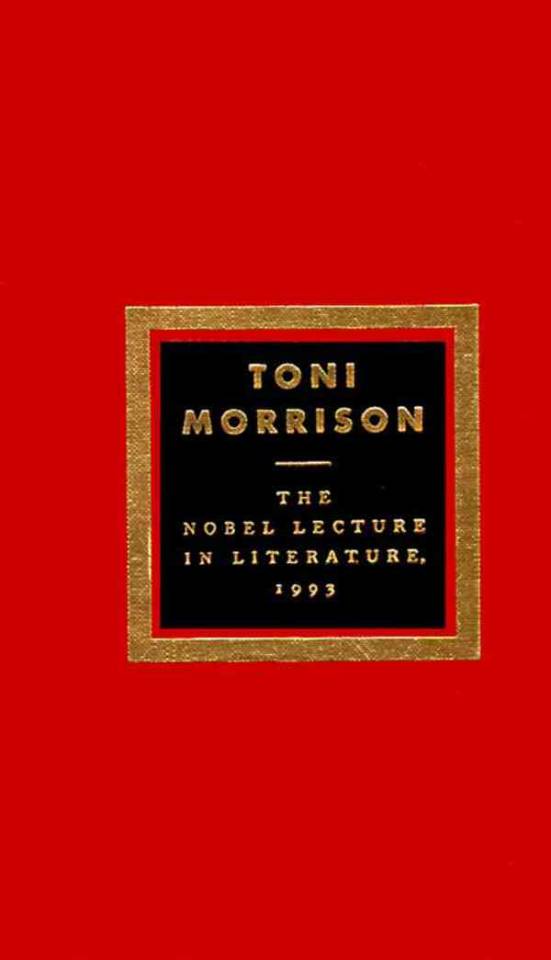
My attention span is short.
If, like so many of us, you’ve found the anxiety-ridden free time of the pandemic not exactly conducive to deep reading, I’d start with her Nobel Lecture in Literature. It is a slim 10 pages, available as a digital download and it is a powerful meditation on why we read, why writers write, and why it matters.
It is, from beginning to end, chock full of the gorgeous, sugar-spun prose that the Nobel Prize judges noted when deciding to award the prize to Morrison, “who in novels characterized by visionary force and poetic import, gives life to an essential aspect of American reality.”
It was in this speech that she first uttered the words, “We die. That may be the meaning of life. But we do language. That may be the measure of our lives.”
Relevant to the moment we’re in — and any hard times still to come — she offers up both an invitation and an invocation for the power of vulnerability to transform our relationships and ourselves: “For our sake and yours forget your name in the street; tell us what the world has been to you in the dark places and in the light. Don’t tell us what to believe, what to fear. Show us belief’s wide skirt and the stitch that unravels fear’s caul.”
And she does what she did better than almost anyone else, bring to life the humanity of enslaved African-Americans, writing them so real that you can almost hear their whisper: “Tell us about a wagonload of slaves, how they sang so softly their breath was indistinguishable from the falling snow.”
Published March 1, 1994, 40 pp.
Buy this book: Local booksellers, Barnes and Noble, Amazon.
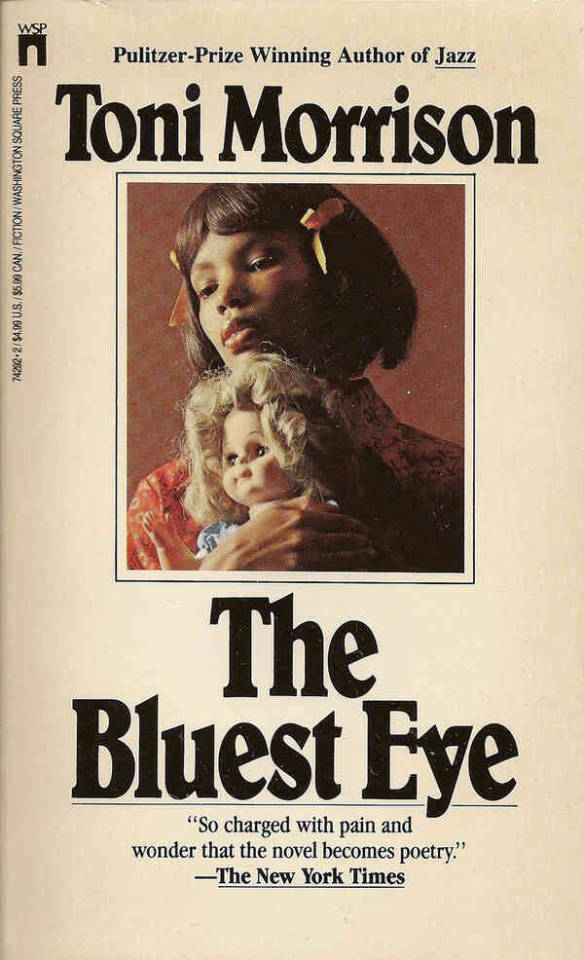
I want to read one powerful, not too long, book.
Published in 1970, Morrison’s debut novel, “The Bluest Eye,” tells the story of Pecola Breedlove, a Black girl who has so deeply absorbed that whiteness conveys privilege and beauty and — this is important — protection, that she prays for God to turn her eyes blue.
It’s worth mentioning that white characters are rare in Morrison’s novels and among the many things this does is erase the prospect of easy villains. In “The Bluest Eye,” for example, the focus is always on Pecola — her jeopardy, her world view, her survival.
As Morrison would later tell The Times, “I was eager to read about a story where racism really hurts and can destroy you.”
But the book itself is by no means polemic. This is Morrison showing us how much she has mastered craft. There is not a single word in this novel that wasn’t considered, chosen and polished with the kind of love a real Pecola Breedlove would long for. An example: “Nuns go by as quiet as lust and drunken men and sober eyes sing in the lobby of the Greek hotel.”
Published 1970, 224 pp.
Buy this book: Local booksellers, Barnes and Noble, Amazon.
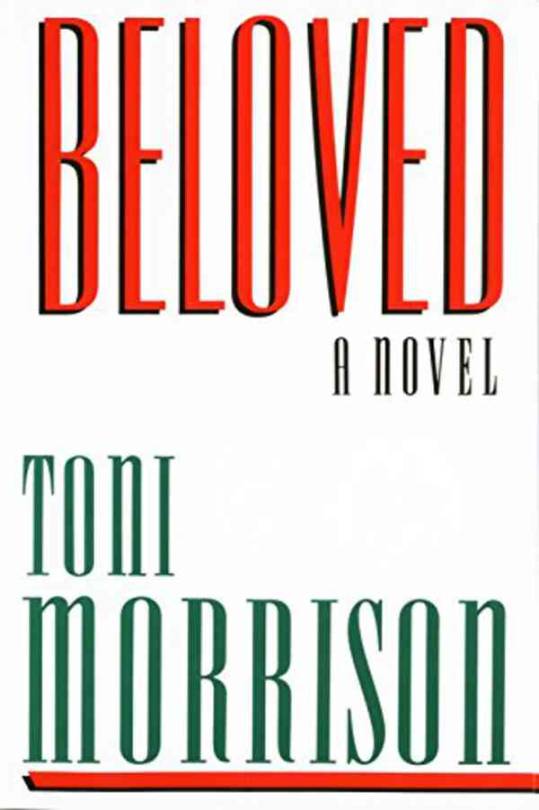
I want to read a masterpiece.
“Beloved” is considered Morrison’s most important novel and rightly so. Many know it from the movie adaptation that was produced by and stars Oprah. The novel was inspired by the true story of Margaret Garner, a runaway enslaved woman, who decided when realizing that her captors were upon her, killed her daughter rather than allow her to return to the brutality of plantation life. It had been Garner’s aim to kill all four of her children before killing herself. It was a case that made papers across the nation, including The Times.
As Rebecca Carroll wrote in her Overlooked obituary of Garner, “Garner’s story has been preserved in history as both sensational and singular. It writ large a question that had been unanswered in the homes and hearts of whites in pre-Civil War America: Was slavery a fate worse than death? Garner, with knife in hand, gave an answer that was impossible to ignore.”
Morrison would go on to write the libretto for an acclaimed opera about Garner. In 2010, she told NPR, “"The interest is not the fact of slavery, but of what happens internally, emotionally, psychologically, when you are in fact enslaved and what you do you do to try to transcend that circumstance. And that really is what Margaret Garner reveals.”
“Beloved” is Morrison at the height of her gifts, asking and answering dozens of questions across the narrative: What is required in motherhood when the world is at its most menacing? What might this story tell us about life after death, love after despair, the healing power of forgiveness and the shelf life of vengeance and rage?
As Morrison once told the critic Hilton Als, “I didn’t want to grow up to be a writer, I wanted to grow up to be an adult.” And so in “Beloved,” as we will in other novels like “Jazz" and “A Mercy,” we get to see what a grown-up love looks like. When Paul D., who was enslaved at the same plantation as Sethe, the protagonist, describes their relationship, he never needs to use the word “love” to say what she means to him: ““There are too many things to feel about this woman. His head hurts. Suddenly he remembers Sixo trying to describe what he felt about the Thirty-Mile Woman. “She gather me, man. The pieces I am, she gather them and give them back to me in all the right order. It’s good, you know, when you got a woman who is a friend of your mind.”
Incidentally, “The Pieces I Am” is also the name of the powerful documentary on Morrison.
Published Aug 12, 1987, 288 pp.
Buy this book: Local booksellers, Barnes and Noble, Amazon.
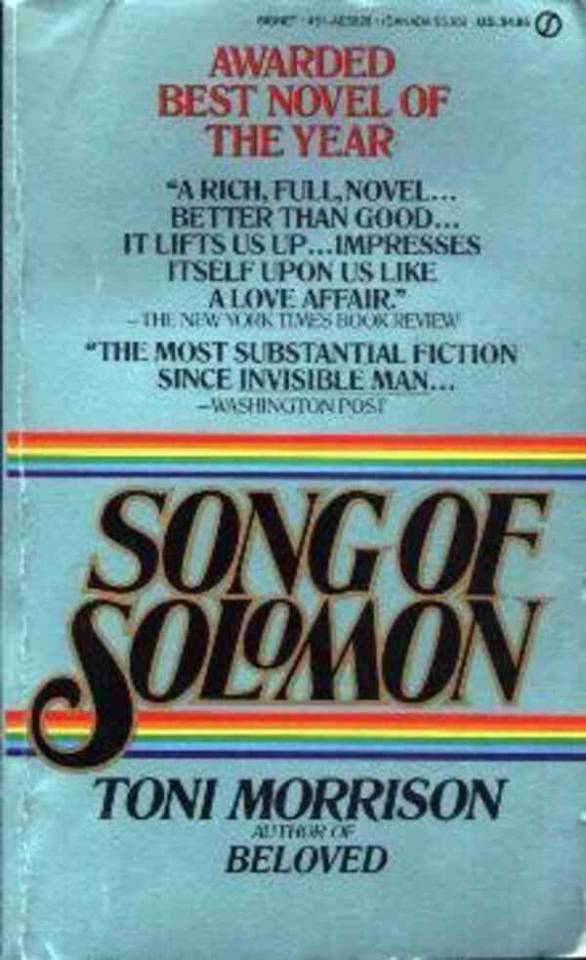
I love Marvel, mythology and origin stories.
“Song of Solomon,” the story of one Macon “Milkman” Dead, is infused with Morrison’s love of language and mythology. It begins with his birth the day after an insurance agent attempts to fly from the roof of the local hospital: “I will take off from Mercy and fly away on my own wings. Please forgive me. I loved you all.''
The palette of language Morrison uses in “Song of Solomon” is particular and vast. As she once said, “In my own family, there was street language, there was sermonic language.You know people actually quoted the Bible to you.” Morrison weaves that mixture of languages, high and low, slang and holy into a quest where the hero of the story searches for gold, purpose, meaning and truth.
In an interview about the book she said, “ “I was very enchanted with the myths and sagas, and, you know, mythological stories that had been told to us as we were kids. Because I thought, the one thing you can say about a myth is that there’s some truth in there, no matter how bizarre they may seem.
“And the one that I had always heard that seemed like just a child's wish was the one about Black people — Black slaves — who came to the United States, and under certain circumstances, they would fly back to Africa.”
She went on to explain that of course, the mythography that there were enslaved people who could fly had to do with escape. What struck her in reading narratives of former enslaved people that were collected in the 1930s was that this was a myth that came up again and again. Some people said they’d heard of people who could fly. Some claimed to have seen it with their own two eyes. But no one, Morrison noted, ever told an interviewer that the question was crazy or unheard of. The mythology of flight and freedom was deeply familiar to all of the former slaves. Throughout “Song of Solomon,” there is a beautifully woven thread of the possibility that this ancestral folk tale of black people and flight is true. (You can read more about this phenomenon in Virginia Hamilton’s powerful collection of African-American folktales and myths, “The People Could Fly.”)
Published 1977, 337 pp. Buy this book: Local booksellers, Barnes and Noble, Amazon.

I want to read a story about female friendships.
“Sula” is about two women, cherished friends, who take decidedly different paths. Hilton Als wrote, “Part of the extraordinary power of ‘Sula’ is that it’s a world where men are not the focus. It’s the sound of women’s voices that takes precedence, makes the story.”
At one point in the novel, Sula returns home, and the grandmother who raised her says, “Well, don’t let your mouth start nothing that your ass can’t stand. When you gone to get married? You need to have some babies. It’ll settle you.”
Sula’s response? ““I don’t want to make somebody else. I want to make myself.”
How does a woman make herself? How can two women be friends when they make radically different choices about what their lives might look like? What can you forgive in a friendship and where is the line when the friend who is outlandish, bold and maybe just a little bit unhinged, becomes more of a liability than an inspiration? A full 25 years before books and shows like “Sex and the City” portrayed female friendship as being the emotional center of smart and daring women who wanted to live by their own rules, “Sula” posited that two straight women could actually be the love of each others’ lives.
Published November 1973, 192 pp.
Buy this book: Local booksellers, Barnes and Noble, Amazon.

I love books, but make it fashion.
“Tar Baby” is the story of Jadine, a beautiful fashion model based in Paris, and the man she falls in love with — a working class guy from northern Florida called Son. (His father is known as the Old Man.) Can star-crossed lovers from different classes make it? As Jadine and Son traverse each other’s worlds, the question comes up again and again: What is home for these entirely different Black Americans? Is there one place where they can both feel whole?
Jadine and Son’s banter is so light and playful, one can only imagine the delight Morrison took in constructing it.
“Imagine something. Something that fits in the dark. Say the dark is the sky at night. Imagine something in it.”
“A star?”
“Yes.”
“I can’t. I can’t see it.”
“Okay. Don’t try to see it. Try to be it. Would you like to know what it’s like to be one? Be a star?”
“A movie star?”
“No, a star star. In the sky. Keep your eyes closed, think about what it feels like to be one.” He moved over to her and kissed her shoulder. “Imagine yourself in that dark, all alone in the sky at night. Nobody is around you. You are by yourself, just shining there. You know how a star is supposed to twinkle? We say twinkle because that is how it looks, but when a star feels itself, it’s not a twinkle, it’s more like a throb. Star throbs. Over and over and over. Like this. Stars just throb and throb and throb and sometimes, when they can’t throb anymore, when they can’t hold it anymore, they fall out of the sky.”
This novel is also a terrific way to explore Morrison, the naturalist. She slows down time when she takes in nature, with a wonder and precision that brings to mind the poet Mary Oliver. One example: “Bees have no sting on Isle des Chevaliers, nor honey. They are fat and lazy, curious about nothing. Especially at noon. At noon parrots sleep and diamondbacks work down the trees toward the cooler undergrowth. At noon the water in the mouths of orchids left there by the breakfast rain is warm. Children stick their fingers in them and scream as though scalded.''
Published Mar 12, 1981, 320 pp.
Buy this book: Local booksellers, Barnes and Noble, Amazon.
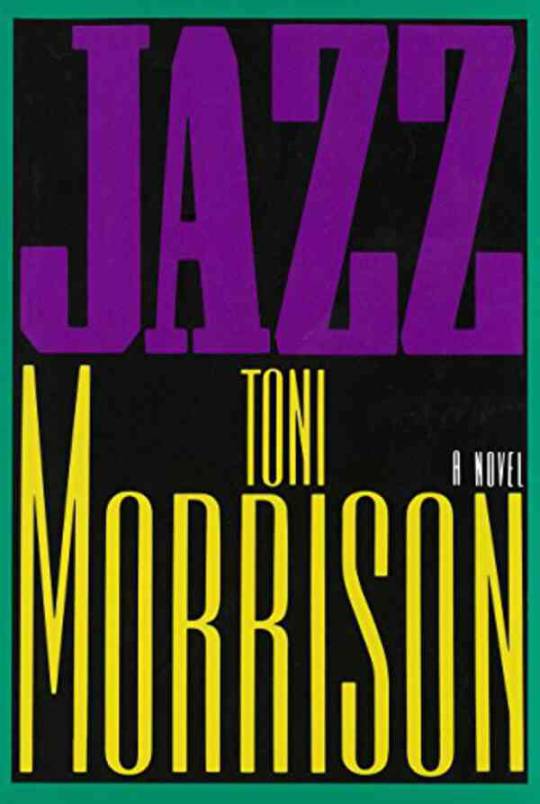
I want historical fiction that swings.
“Jazz” is the story of a love triangle gone violently wrong. But it’s also about Harlem in the 1920s. It is Langston Hughes and Zora Neale Hurston, Paul Robeson and Josephine Baker. It is shiny and powerful, hopeful and talented, it swings with possibility.
One of my favorite passages of all time in any book is from “Jazz,” and it goes like this: “I'm crazy about this City. Daylight slants like a razor cutting the buildings in half. In the top half I see looking faces and it's not easy to tell which are people, which the work of stonemasons. Below is shadow where any blasé thing takes place: clarinets and lovemaking, fists and the voices of sorrowful women. A city like this one makes me dream tall and feel in on things. Hep.”
James McBride, the award-winning author who is also a musician, wrote in this paper that “it is through jazz, actually, that one can best understand the imaginative power and technical mastery that Morrison has achieved over the course of her literary journey. No American writer I can think of, past or present, incorporates jazz into his or her writing with greater effect. Her work doesn’t bristle with jazz. It is jazz. Her novel of the same name is an homage to the genre. Jazz eats everything in its path — rock, classical, Latin. Like the great jazz musicians who evolved out of bebop and moved to free jazz, and whose later work demands listening, Morrison’s later novels are almost as enjoyable listened to as read. That is why, I suspect, she spends exhausting hours in the studio recording her books, instead of letting actors do the job. She’s the bandleader. She wrote the music. She knows where the song is going.”
Morrison recorded most of her own audiobooks, and to hear her say these words and so many others compounds the value of the gift of her narrative. Pat Conroy said that the four most important words in the English language are “tell me a story.” Hearing Morrison read her novels is like having the most elegant, erudite, elder in your tribe saying, “Come. Sit next to me, let me tell you a story.”
In every book, and on every page, one gets the sense that Morrison, who did not publish her first novel until she was 39 and did not quit her day job until more than a decade later, took the art of fiction as a solemn calling. Everything she put on the page was carefully constructed. We feel at home in the pages of her novel because her work is orchestral in scope and yet, especially in the audiobooks, there is always this enchanting intimacy that pulls you in. The books are important and mighty works of American literature, and yet somehow, it feels like she is speaking, writing, singing, just to you.
Published Apr 07, 1992, 229 pp.
Buy this book: Local booksellers, Barnes and Noble, Amazon.
Photograph by Sara Krulwich/The New York Times.
Produced by Rumsey Taylor.
0 notes
Text

questions & answers about your oc!
i was tagged by the lovely @wa-royal-tea! i’m super late to this, but it was sm fun to do and a really good character writing exercise !! i’m tagging @nexility-sims, @thestenhams, and @evandroyals for this oc questions & answers tag game 💗
q&a is under the cut!!

1) What is your favorite sport?
Soccer! Or football, depending on where you’re from, I guess.
2) What is your favorite color?
Sage green. Everything in my bedroom is sage green! But I also like medium blue, like a Pantone dresden blue. Is that too specific?
3) What is your favorite movie?
That’s an easy one. Halloweentown, for sure.
4) Taken? Single?
Are you allowed to ask that? You are? Umm... next question, please.
5) What would be your perfect day?
Having my mama be home, since she’s always busy. She’d cook us all her Simyeon scallion pancakes for breakfast, and I’d play with my little brother, Rhys. If my papa’s not busy, we’d go down to the beach and play soccer for hours.
6) Are you a night owl or an early bird!
I’m an early bird. Usually, I’m the first to wake up in the morning.
7) Do you think you’re smart?
That’s a trick question, right? I guess I’m smart? I get better grades than my twin sister.
8) How do you like to be comforted when you’re sad?
I don’t like being alone when I’m sad. I want someone to distract me with macarons and mochi and make me laugh.
9) Where do you want to be in 5 years time?
In five years, I’ll be like 25 years old? And by then, I’ll have graduated university and started preparing to work as a full-time royal. I’d like to play soccer professionally but— uh, never mind. Where I want to be and where I’m going to be are different.
12) Do you have any regrets?
No, not yet! I hope I won’t have any.
13) Who are/is your best friends?
My twin sister, Lina, is my best friend. I feel like we understand each other better than other people do? But I’m also really close with my friends I met at boarding school. Ren, Arthur, Nora, and Penny! I love them.
14) What was your dream last night?
Last night, I dreamed I fell into a puddle and was transported into this alternate reality. The sky was purple and there were monsters everywhere! I usually have really wild dreams... though they’re mostly nightmares.
15) Who in your family are you closest to?
Lina, obviously! I’m also really close with my papa.
16) What is the one thing people don’t know about you?
I have asthma. I try to control it as much as possible— and always take my medication— so that when I’m playing soccer or working out I won’t have an asthma attack.
17) Best present ever given to you?
When I was 12 years old, I went through an embarrassing photography phase. Mama bought me a brand new DSLR for Winterfest! I think it’s a Rikon, or something. I’m starting to get back into taking pictures of special moments and the people I love.
18) What is your favorite food?
Anything my mama makes. But my favorite would have to be her homemade dumplings. And we always have it with this secret sauce she makes. It’s the best thing I’ve ever tasted. I could cry thinking about it.
19) Earliest childhood memory?
I was like three years old, and I remember watching my papa look out the window. It was snowing. I think he hates the snow.
20) Do you have a crush?
I... do, but it’s none of your business.
21) If you could live in a different period, which one would it be?
I’d rather live in this time period. We have technology, cars, cellphones, and a modern understanding of hygiene. That’s good enough for me.
22) Any nicknames?
A lot of people call me Clem.
23) Introvert or Extrovert?
I love talking to people and making new friends, so that makes me an extrovert.
24) Favorite book?
Pachinko by Min Jin Lee. A close second is These Violent Delights by Chloe Gong.
25) Hobby?
Aside from soccer and anything athletic, I like photography, painting even though I’m really bad at it, reading, and journaling— you know, with the cute calligraphy pens and stuff.
26) Beach or pool?
Beach. There’s nothing better than laying out at the beach and feeling the sun on your skin.
27) First kiss?
Seriously?
28) Favorite subject
Anything science-related. History, too!
29) Age
I’m 19! I turn 20 years old next month.
30) Full name
Clementine Beauchamp.
31) Pets?
I don’t have any.
33) Favorite song?
I can’t choose! Right now, my favorite song is Step On Up by Ariana Grande.
34) Where do you live?
At my parents’ house?
35) What/who do you miss?
I miss my... close friend, Ren.
36) Which school(s) do/did you go to?
I’m a freshman at Foxbury Institute.
38) Tattoo?
Uh, no. Those hurt.
39) Done anything illegal?
Huh? Illegal? Nope.
40) Fav TV show?
Girl from Nowhere. I love it, even though it’s kind of dark?
41) Do you know any celebrities?
Mama knows celebrities and movie stars, so I’ve met a bunch of them and their kids at her parties. I guess that counts?
42) Dreams/wishes?
I want to be happy.
43) Are you very competitive?
Uh, yes.
45) Greatest accomplishment?
Getting a full-ride soccer scholarship to Foxbury Institute. I hope I’ll become captain of the women’s soccer team by junior year!
46) If you were stuck on a desert island, who would you be stuck with?
My papa. Since he was in the military for a long time, he knows how to survive in all kinds of places.
47) Zodiac sign
I’m an Aquarius sun, Taurus moon, and Aries rising!
48) Where were you born?
At a hospital in Newbury?
49) Sexuality?
I don’t know. Pan?
50) What color are your eyes?
Dark brown.
51) What color is your hair?
... Dark brown.
52) Do you want/ have kids?
I’d love to have children when I’m settled down and comfortable. Two, maybe. A boy and a girl.
53) When is your birthday?
January 21st!
54) Current mood?
I’m fine.
55) Do you send goodnight or good morning texts to people?
Yup! If I’m too busy to text my family and friends during the day, I like to at least message them in the morning or night.
57) How long do you sleep for?
8 hours. From around 10pm to 6am.
58) How long does it take you to get up in the morning?
As soon as I’m awake, I’m ready to go.
59) How long does it take you to get ready?
Including a shower, getting dressed, and all that stuff? I’d say like 20 minutes.
60) Meyer Briggs personality type?
ENFJ.

#thebrixtons#sim: clementine#character q&a#character building#this was actually really fun and challenging!#and i also got to have a cute little photoshoot w clem#it’s not her style but 🧎🏽♀️#anyways...#she’s so cute#i miss her : (#someone find her she’s lost in the handbag closet
29 notes
·
View notes
Text
My Top 10 Underrated Anime Series
1. Welcome to the NHK

Plot: The main protagonist is Tatsuhiro Satō, a university dropout entering his fourth year of unemployment. He leads a reclusive life as a hikikomori, ultimately coming to the conclusion that this happened due to some sort of conspiracy. One day just when his life seems entirely unchanging, he meets Misaki Nakahara, a mysterious girl who claims to be able to cure Tatsuhiro of his hikikomori ways. She presents him with a contract basically outlining that once a day they would meet in the evening in a local park where Misaki would lecture to Tatsuhiro in an effort to rid him of his lifestyle. During these outings, many subjects are discussed, though they almost always pertain in some way to psychology or psychoanalysis. One of their first meetings in fact deals with interpreting Tatsuhiro's recent dreams. Both Tatsuhiro and Misaki, however, have a tendency of over-doing things, such as hiding the truth, especially from each other and themselves. Despite Misaki's offer and pressing attempts at salvation, it is Tatsuhiro's neighbor and high school friend, Kaoru Yamazaki, whom Tatsuhiro often turns to in moments of need and support. Despite his own idiosyncrasies, Yamazaki is one of the more stable characters in the story.
While many may not know about this series, those who do know of its existence can see it’s appeal. This anime shows that some people, like the main character, are shut-in’s due to social anxiety holding them back from living a regular life. The anime deals with subjects such as social anxiety, hiding depression from loved ones, paranoia, and a crippling fear of never being accepted by the outside world.
Throughout the series, Sato tries to go outside more often and is pushed to do this by a high school girl, Misaki, and his old classmate now neighbor, Kaoru. All the while, Sato meets some people from his past who cause him to go down a different path, such as becoming part of a ponzi scheme or joining a suicide group, because they themselves have problems that he unknowingly becomes a part of. This goes to show that if you have struggles with batting depression or have family problems...seek proper help before bringing others down with you.
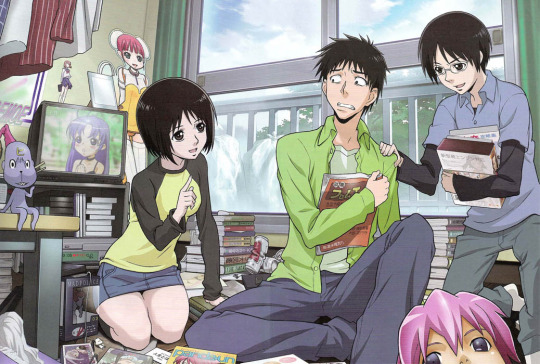
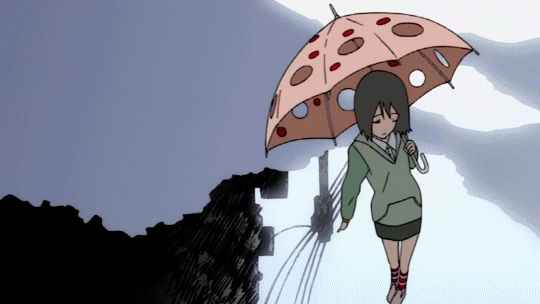
2. Tiger & Bunny

Plot: The series takes place in "NC 1978" in a fictional, re-imagined version of New York City called Stern Bild City, where 45 years before, superpowered individuals known as "NEXT" (an acronym standing for Noted Entities with eXtraordinary Talents) started appearing and some of them became superheroes. Each of the city's most famous superheroes work for a sponsor company and their uniforms also contain advertising for real-life companies. Their heroic activity is broadcast on the popular television show "Hero TV", where they accumulate points for each heroic feat accomplished (arresting criminals or saving civilians, for example) and the best ranked hero of the season is crowned "King of Heroes". The story mainly focuses on veteran hero Kotetsu T. Kaburagi, a.k.a. Wild Tiger, who is assigned a new partner: a young man named Barnaby Brooks, Jr. However, Barnaby and Kotetsu have trouble working together, as they have conflicting opinions on how a superhero should act, while at the same time they are trying to crack the mystery of the murder of Barnaby's parents. In addition, the appearance of a homicidal vigilante NEXT named "Lunatic" stirs up the public and makes them question the place of heroes in the city.
The main heroes, Kotetsu and Barnaby, do not like each other at first...but a strong bond grows between them as they protect the city and help each other from the tragic moments of their pasts. They even help each other with the problems that they face within the series’ current timeline: Kotetsu slowly losing his powers, and Barnaby being manipulated by someone who he thought of like family.
While not as big as My Hero Academia, this series still has lots of good moments, terrific super heroes, and powerful storylines. Tiger & Bunny is definitely worth watching for anyone who loves superheroes and anime.
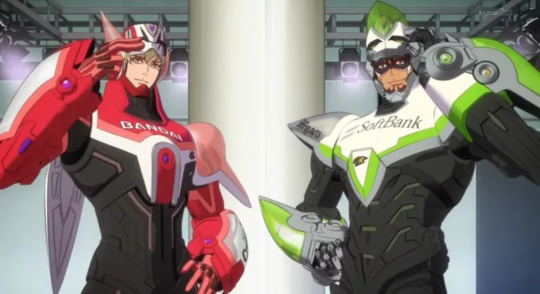
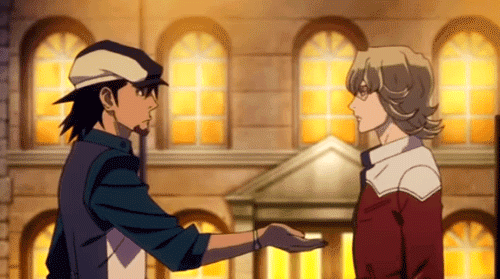
3. My Roommate Is A Cat
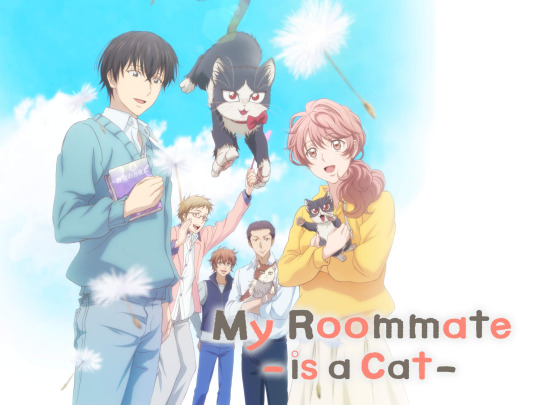
Plot: Novelist Subaru Mikazuki, who is shy and not good with other people, and Haru, the cat that has been living a severe stray life. This is a story of them suddenly living together and describes the happiness of living together from both point of views.
This series is definitely underrated. My Roommate is a Cat is filled shows how much of an impact a person...or in this case a cat...can have on a person who has lived a life of solitude and books. The main character, Subaru Mikazuki, begins to slowly open up to those around him thanks to the help of a stray cat: Haru. From Haru’s point of view, Subaru is someone whom she desires to protect and take care of, as she fears that he cannot survive without her. Subaru also comes to term with his parents’ deaths and learns to move past his guilt, and realizes that there are many people who love and care for him.
This series shows that it’s ok to open up to the people around you, and that no one is truly alone.
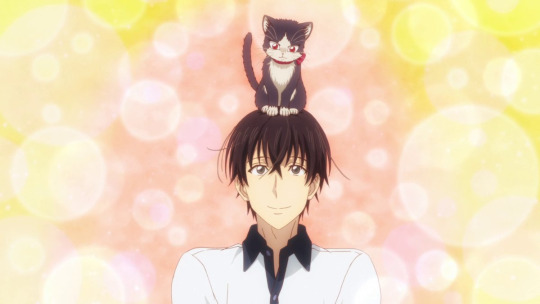
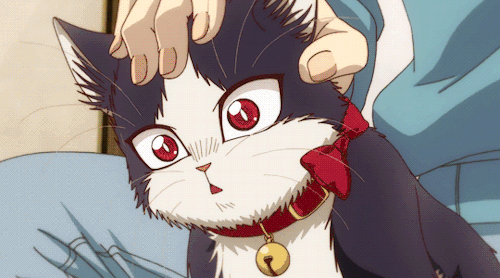
4. And Yet The Town Moves
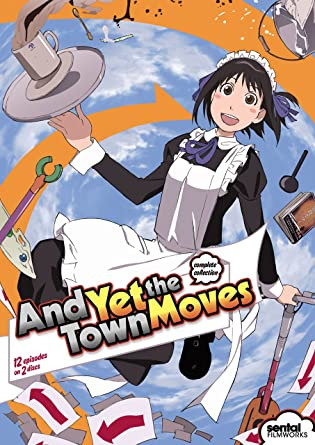
Plot: Hotori Arashiyama loves mysteries, but there’s one she just can’t solve: why does the solution to one problem inevitably seem to lead to another? Like how when Hotori has to start working at the Seaside Maid Cafe after school to pay off a debt and her friend Toshiko fortunately knows exactly how a Maid Cafe should be run. Which is fortunate since Hotori has no clue. Except that, unfortunately, Toshiko has no interest in working at the cafe—until she discovers that Hotori’s childhood friend Hiroyuki is a regular. Which SEEMS fortunate. Except that Hotori doesn’t know that, while Toshiko likes Hiroyuki, Hiroyuki secretly likes Hotori, while Hotori secretly has a crush on… No, no more spoilers!But if that’s not enough drama, there’s work, angst with a certain math teacher, table tennis between her classmates, her younger brother versus the school’s bad girl… And yet, even though everything seems like it’s going to crash at any moment, somehow Hotori’s life keeps going hilariously forward.
Sure...it doesn’t have sexy and cute maids that most maid-theme anime has... But And Yet The Town Moves is still a series worth watching. The series features cute, slice-of-life storylines filled with antics by the mystery-loving Hotori Arashiyama. Because of her crazy antics and goofy nature, Hotori brings laughter and new experiences to those around her.
If you want an anime featuring klutzy maids and funny slice of life, then And Yet The Town Moves is definitely the right choice.

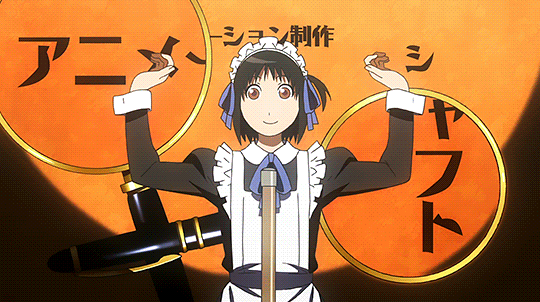
5. Keep Your Hands Off Eizouken!

Plot: Midori Asakusa wants to create an anime, but she's too disheartened to make that first step by herself. By pure chance, she meets Tsubame Mizusaki, an up-and-coming socialite secretly dreaming of becoming an animator. Together with Midori's money-loving best friend Sayaka Kanamori, the energetic trio start the "Eizouken" club and slowly work towards making their "greatest world" a reality.
This anime is truly a one-of-a-kind masterpiece. Keep Your Hands Off Eizouken! has animation that is truly breathtaking and filled with the imaginations of aspiring animators. Throughout the series, our three protagonists: Midori, Sayaki, Tsubame experience the hardships of running their own studio, all the while dealing with the Student Council and School Board who wish to shut down Eizouken. But no matter how hard they try, there is no stopping these three girls from making anime and running their studio.
Keep Your Hands Off Eizouken! has such brilliant animation, creative storylines, and normal looking characters who viewers can relate to. If your dream is to become an animator, than you certainly learn a lot from this series.
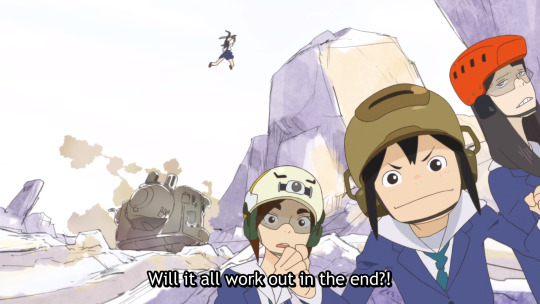
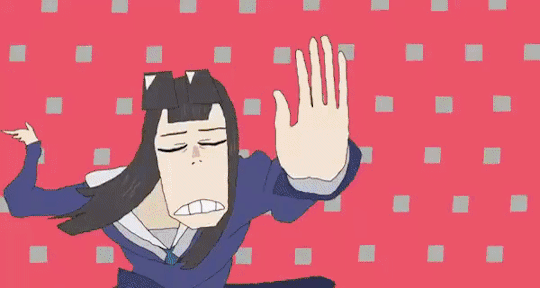
6. Angels of Death
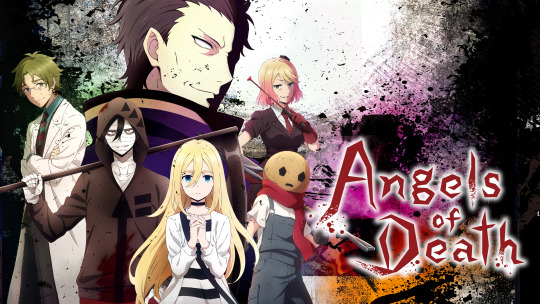
Plot: 13-year old Rachel awakens to find herself trapped in the basement of an abandoned building. Without any memories, or even a clue as to where she could be, she wanders the building, lost and dizzy. In her search, she comes across a man covered in bandages. He introduces himself as Zack and he wields a grim-reaper like sickle.A strange bond is struck between them, strengthened by strange, crazy promises…These two, trapped in this strange building, don’t know why fate has placed them there. But they will work together desperately to find a way out…
Rachel and Zack are quite an unlikely duo...yet their skills and personalities are what complete each other: Rachel is calm and calculating, while Zack is aggressive and strong. But they have something in common: They both suffered their whole lives, became killers, and being killers is what got them trapped in the mysterious building in the first place. Together, they face various serial killers who want to keep them from escaping: A doctor with an eye fetish, a pumpkin-headed child who wants to bury Rachel in his graveyard, a female-prison warden who’s obsessed with punishing ‘sinners’, and a faithless priest whose goal is to test the faith of those who fall victim to the killers within the building.
Angels of Death is filled with such mystery and psychological thrills. While it is not for the faint of heart...it is definitely for those who wish to find a good psychological thriller to watch.
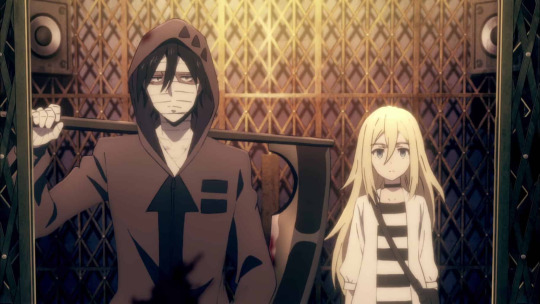
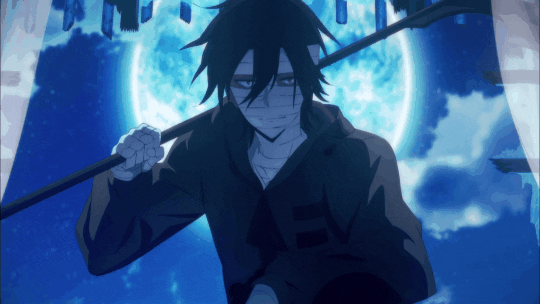
7. Zombieland Saga

Plot: In the year 2008, high school student Sakura Minamoto is abruptly killed by a truck on the morning she plans to submit an idol application. Ten years later, Sakura, along with six "legendary" girls from various eras of Japan's history, are brought back as zombies by a man named Kotaro Tatsumi, who seeks to revitalize Saga Prefecture by putting together an all-zombie idol group known as Franchouchou.
Unlike most ‘pop idol’ anime series, that feature cute girls whose music can save the world...this one features cute girls who are zombies who were brought back to life to save a city as a pop idol group. While it seems unusual, Zombieland Saga shows the viewers all the things that Saga has to offer...because it basically advertises the entire prefecture. The members of Franchouchou: Sakura, Saki, Ai, Junko, Lily, Yugiri, and Tae...are determined to become a great idol group while keeping their true identities a secret. Thanks to their mysterious manager, Kotaro Tatsumi, they are given a second chance at life and learn more about each other...but they also help each other move on from their deaths and give closure to the loved ones that they had to leave behind.
If you are looking for a ‘pop idol girl’ anime that is different from others...then Zombieland Saga is definitely a good choice, as it does differ from the usual plots that anime featuring pop idol groups has.
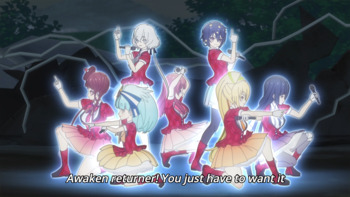
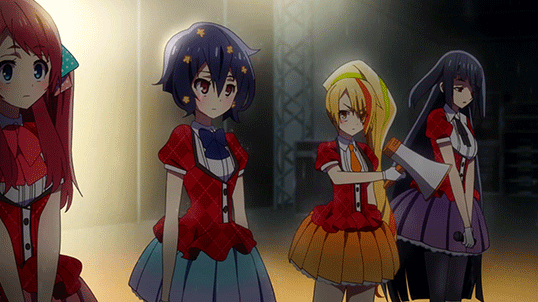
8. Mitsuboshi Colors

Plot: Set in Ueno. The series follows three elementary school girls, Yui, Sat-chan, and Kotoha, who together form an organization known as "Colors". Together, they perform various deeds and errands to protect the peace in their town.
This series is very adorable and is filled with a lot of hilarity. What makes it hilarious, are the crazy antics of the crybaby Yui, the rambunctious Sat-chan, and the dark-humored Kotoha as they try to help others and maintain the peace in the town that they love so much. They recieve help from local shop owner, Pops, who gives them clues to solve, and are often coming into conflict with police officer Saito, who sees them as nothing but trouble while dealing with their childish antics.
Mitsuboshi Colors really does make you want to go to the real Ueno in Japan, and see all the shops featured within this series.

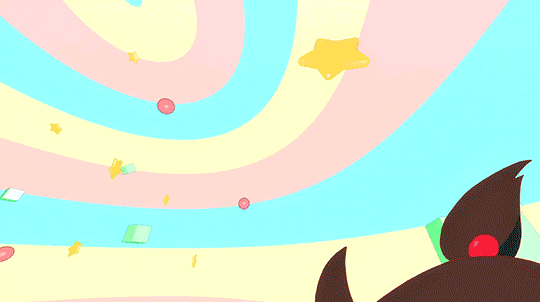
9. Lovely Muco

Plot: The series depicts the life of the pet dog Muco and his owner Komatsu, who lives in his glass-making workshop in the mountains.
Lovely Muco shows life through the eyes of Muco, a shiba inu who lives in a mountain town with her owner, Komatsu, who works as a glass blower. Muco is an energetic dog who finds everything around her fascinating. Muco loves Komatsu more than anything in the world, who gives her lots of love in return. Muco also interacts with other people such as Komatsu’s long-time friend, Ushikou-san, bar owner Bouda and his energetic daughter Rena.
Lovely Muco shows the viewer how the world looks through the eyes of a dog, and what goes through their curious minds.
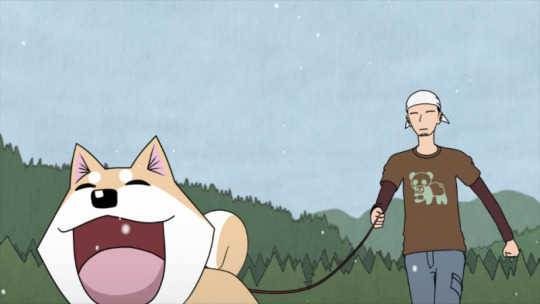

10. Chi’s Sweet Home
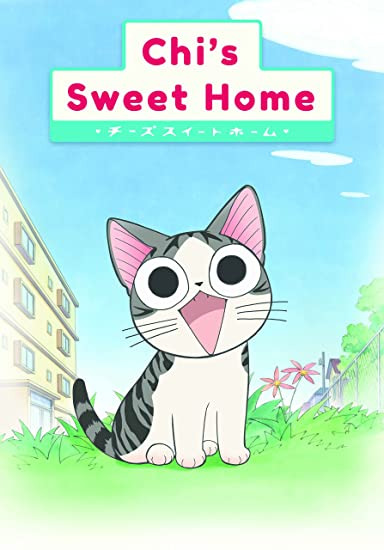
Plot: A grey and white kitten with black stripes wanders away from her mother and siblings one day while enjoying a walk outside with her family. Lost in her surroundings, the kitten struggles to find her family and instead is found by a young boy, Youhei, and his mother. They take the kitten home, but, as pets are not allowed in their housing complex, they try to find her a new home. This proves to be difficult, and the family decides to keep the kitten. While being housebroken, the kitten mistakenly answers to "Chi" (as in shi- from shikko, the Japanese word for "urine") and this becomes her name. Chi then lives with her new family, learning about different things and meeting new people and animals.
This series is filled with so much love and cuteness that it could give you diabetes. Chi’s New Home shows viewers how the world looks through the eyes young kitten ‘Chi’, as she grows to love her human family and makes new friends along the way. Chi and her family love each other greatly, and cannot imagine living without each other.
Chi’s Sweet Home shows us just how important family is, and how a new member of one’s family can bring so much love and joy into one’s life.
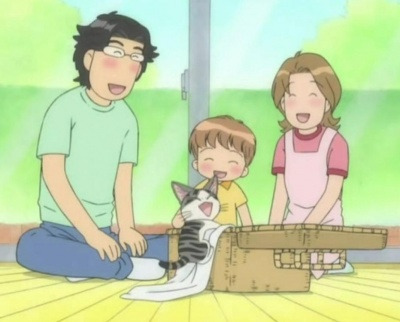

#top 10 list#my favorite#underrated#anime#underrated anime#welcome to the nhk#tiger and bunny#my roommate is a cat#soredemo machi wa mawatteiru#and yet the town moves#zombieland saga#zombie land saga#hands off eizouken#angels of death#lovely muco#mitsuboshi colors#chi's sweet home#chi's new address#cute#funny#psychological#thriller
921 notes
·
View notes